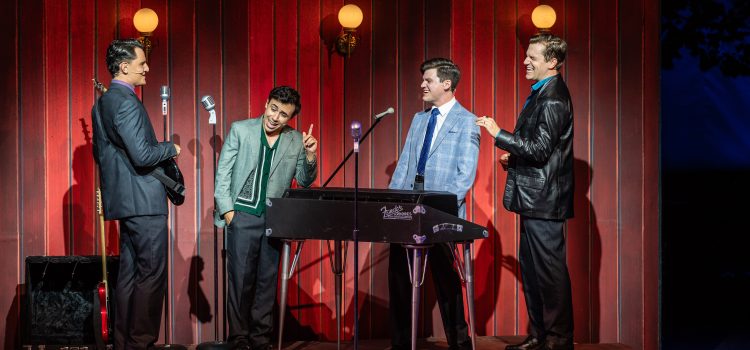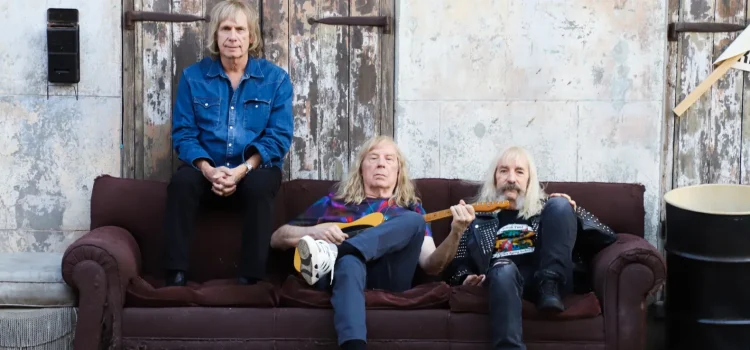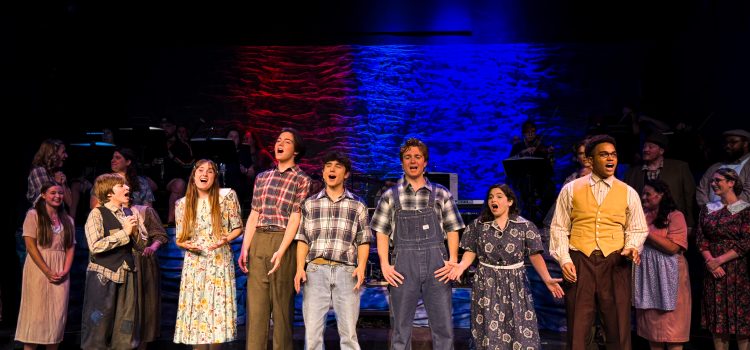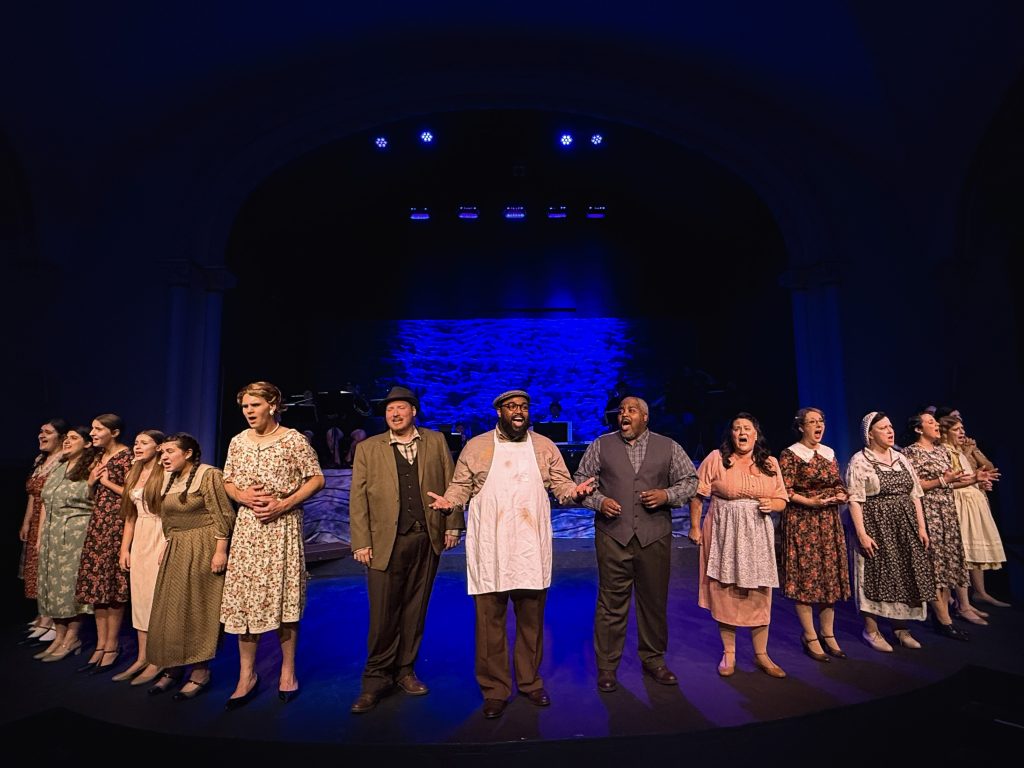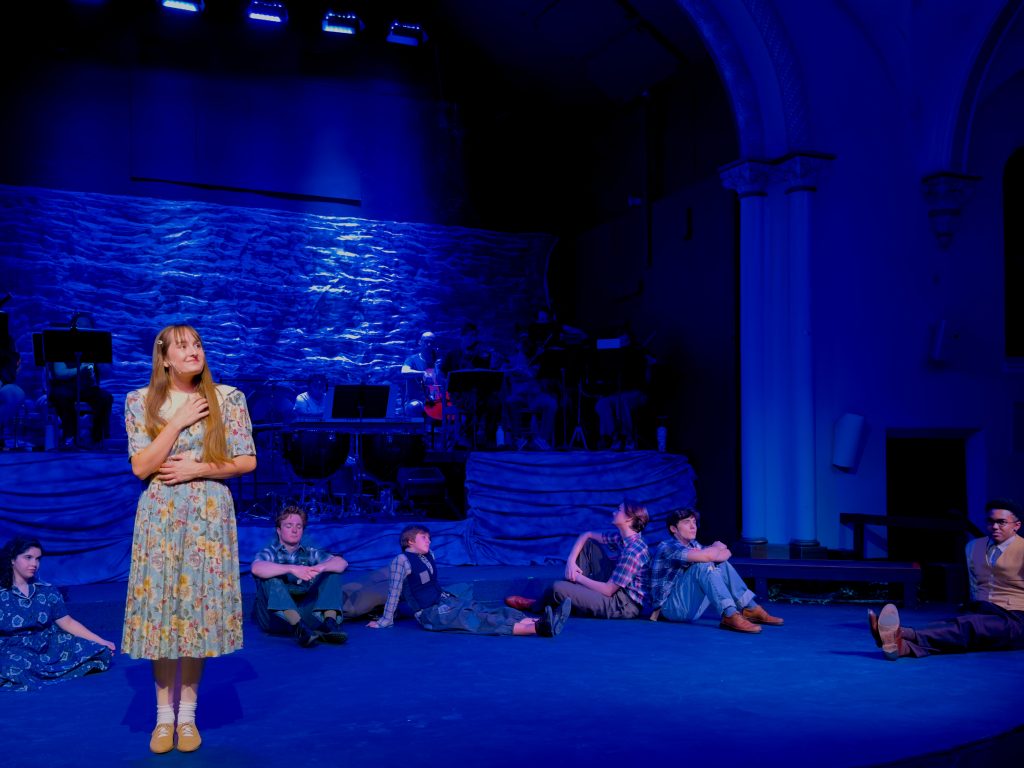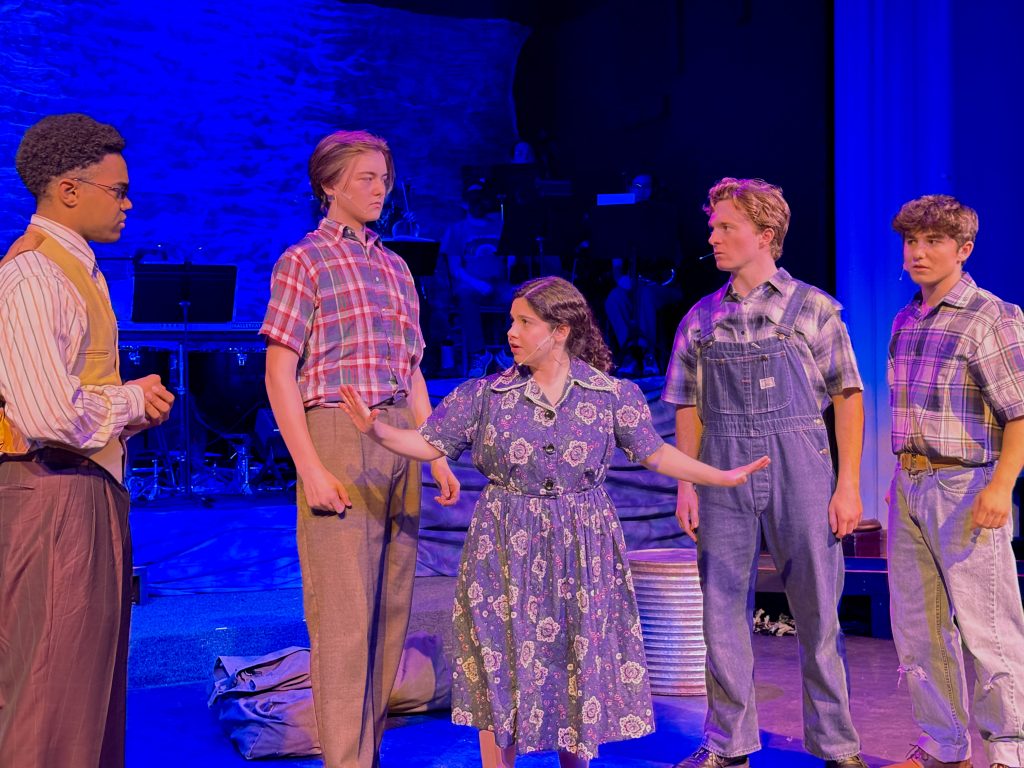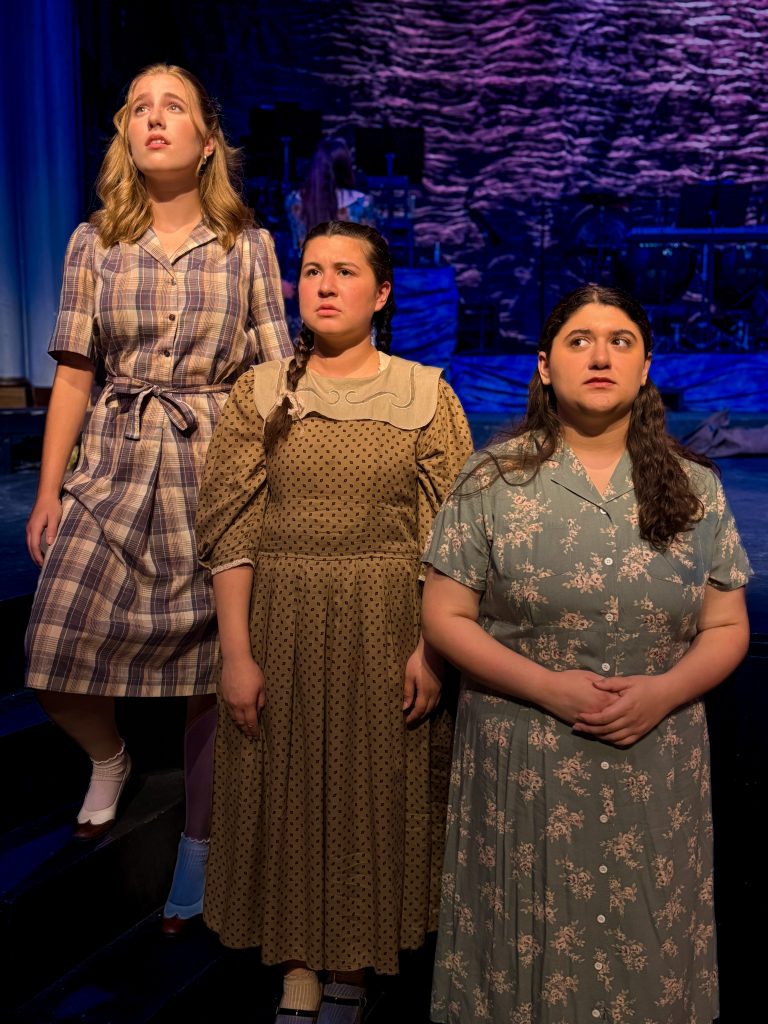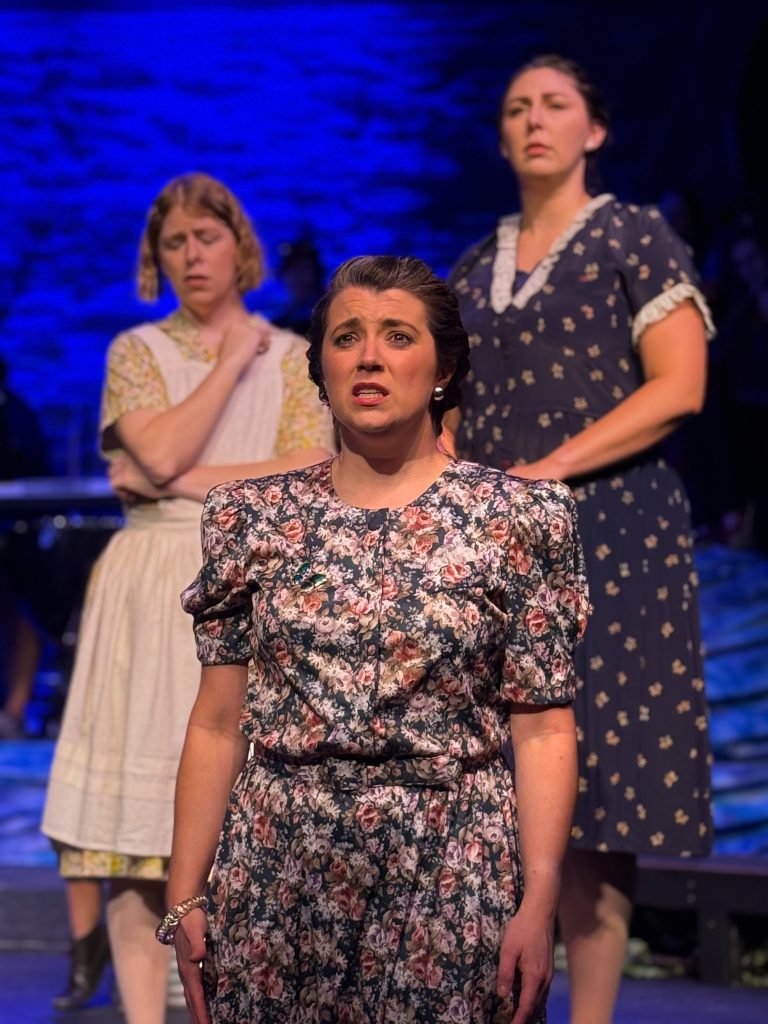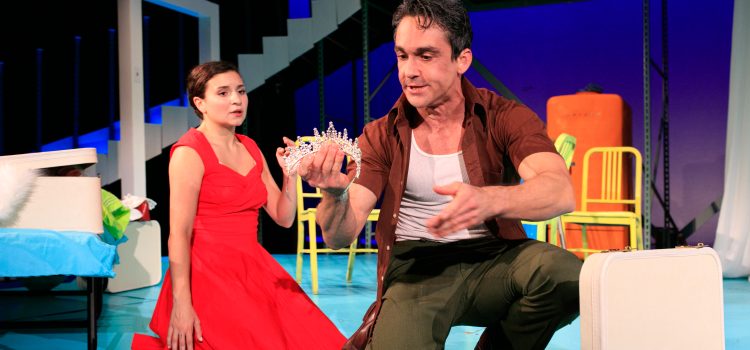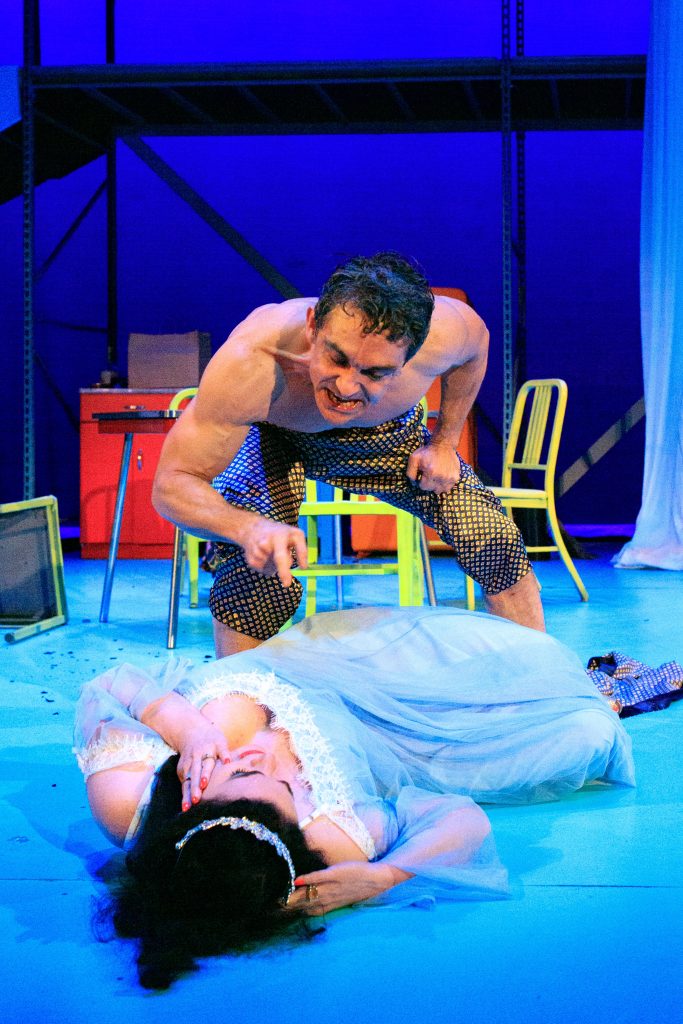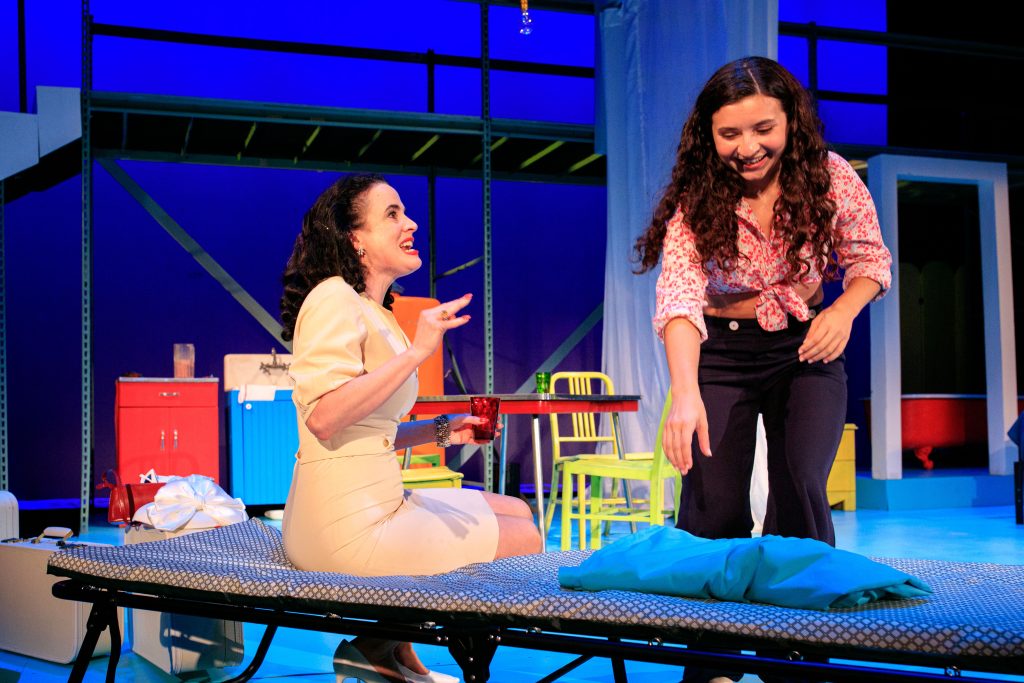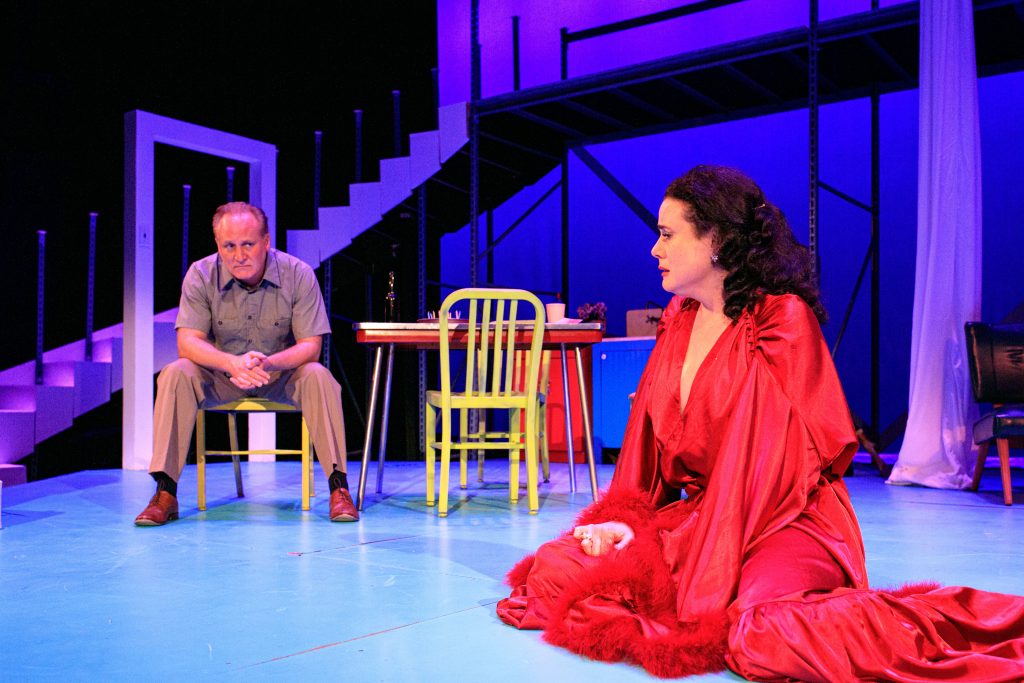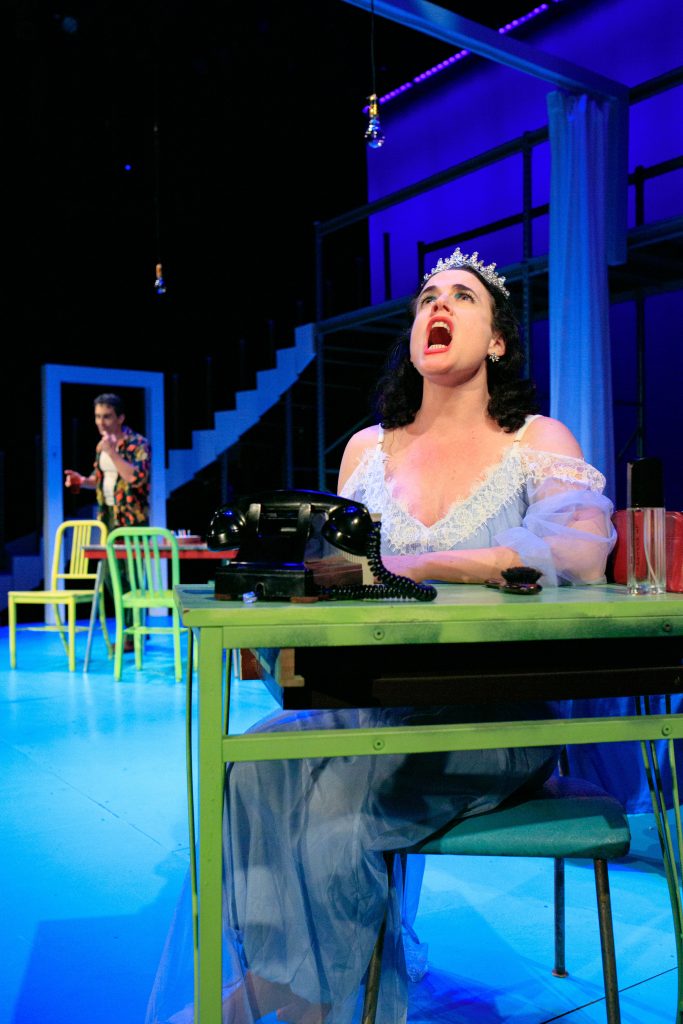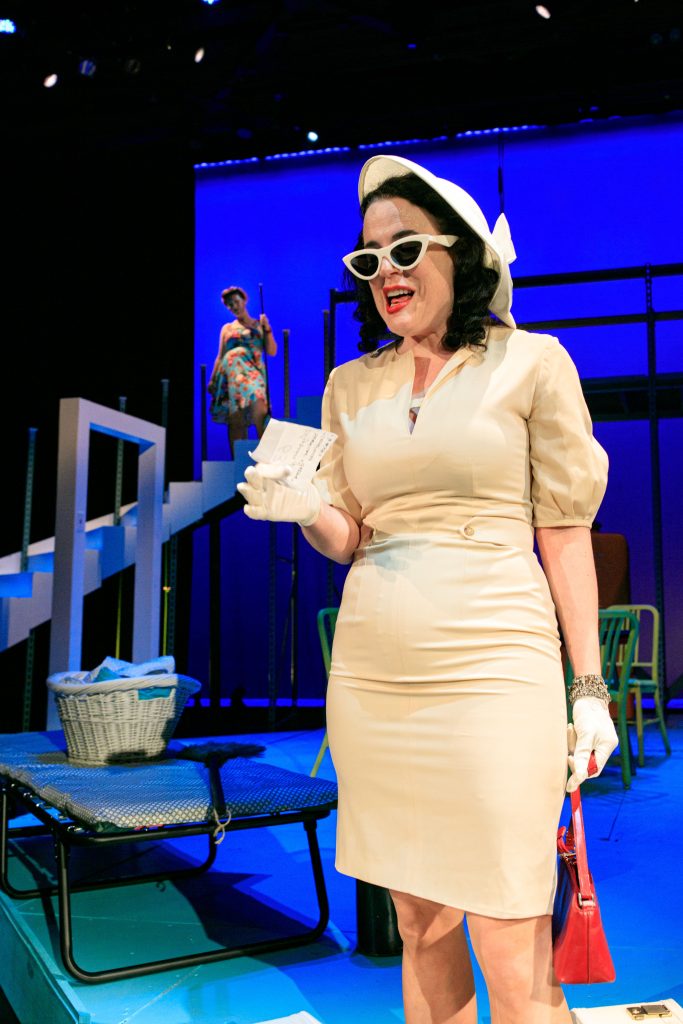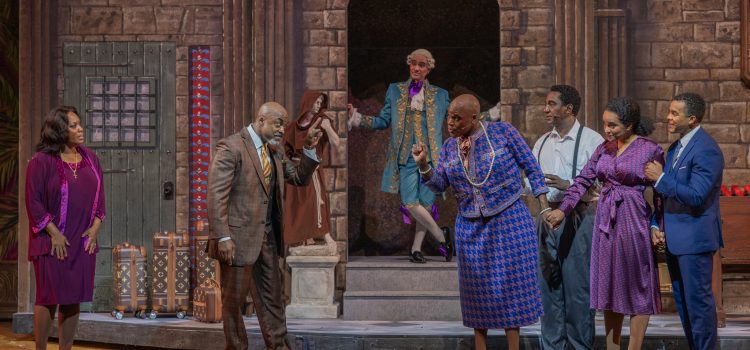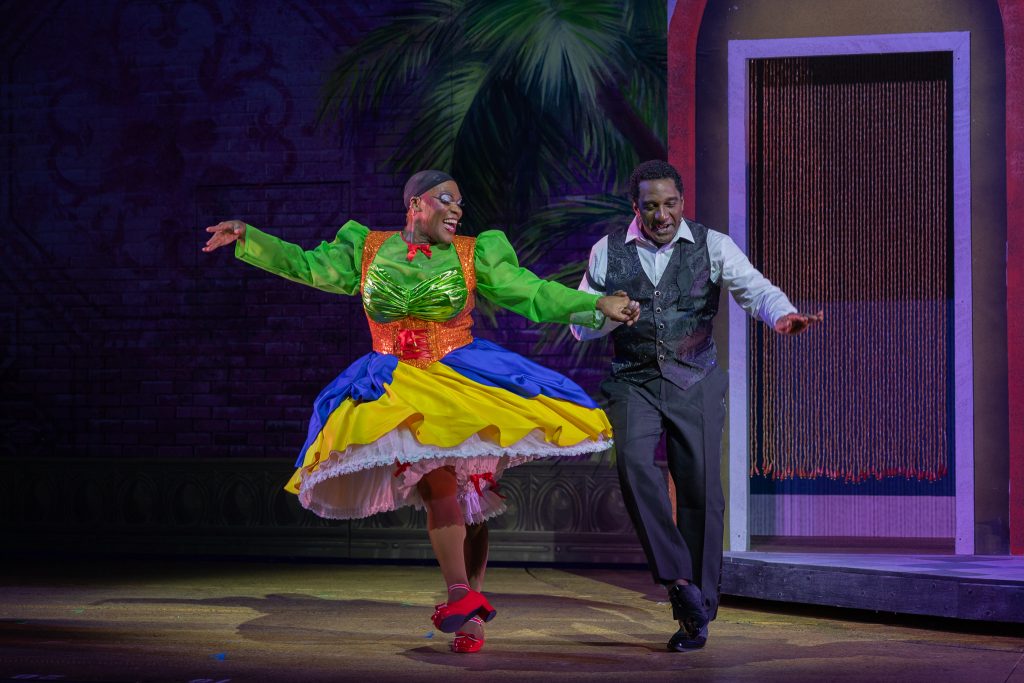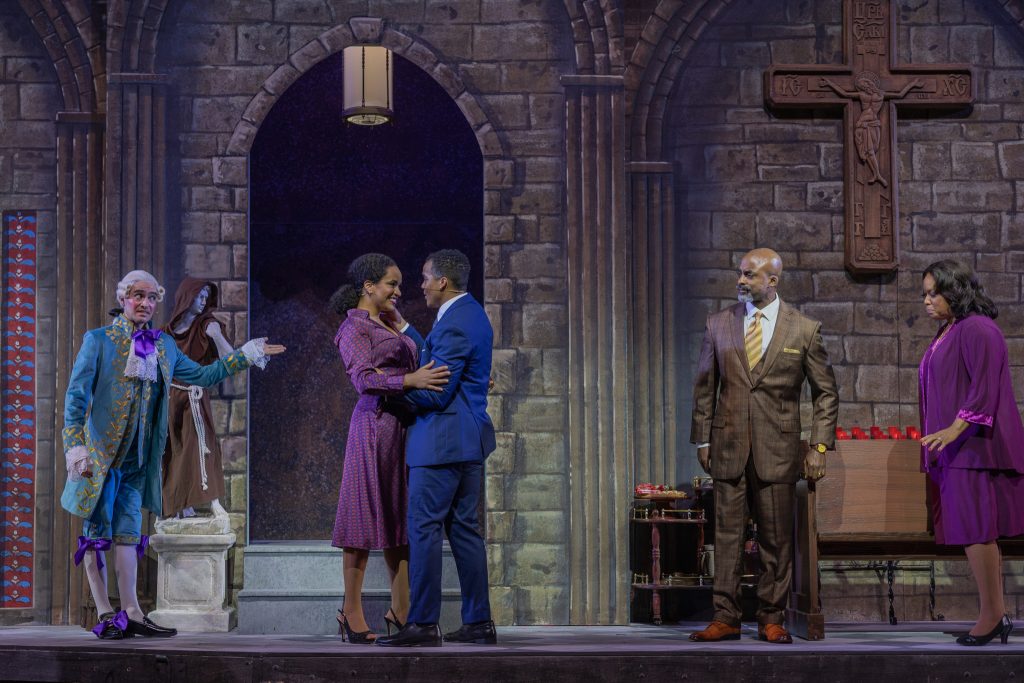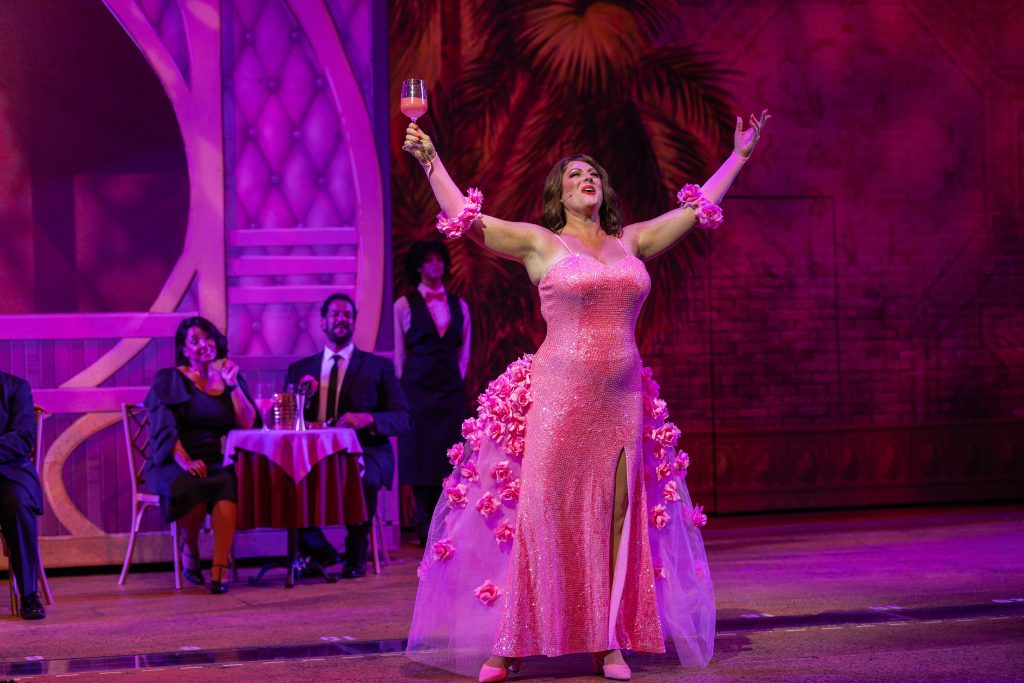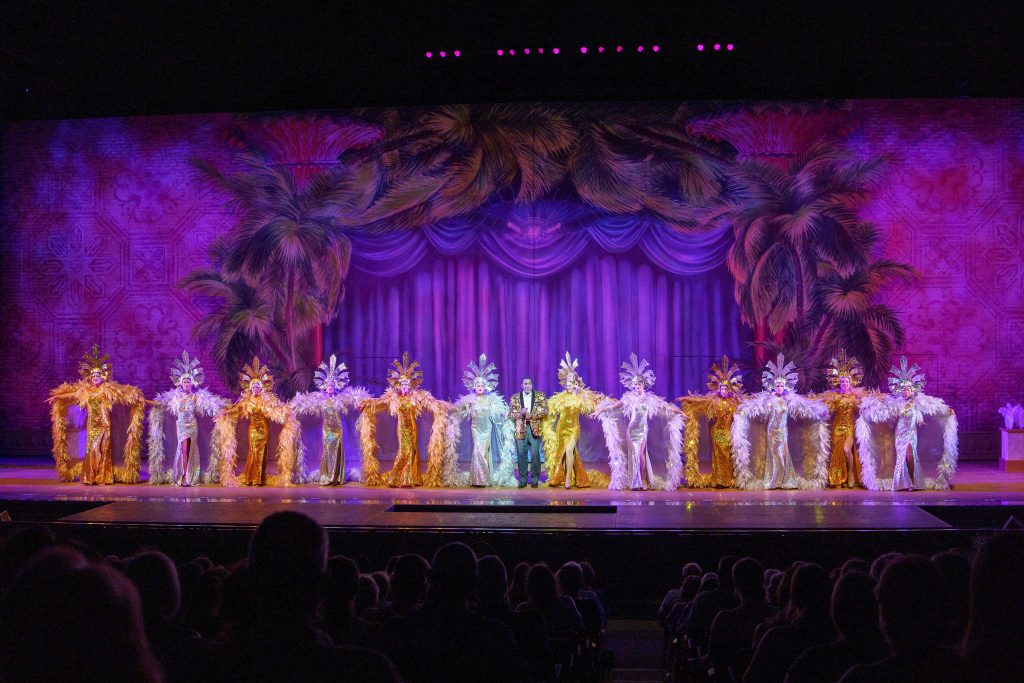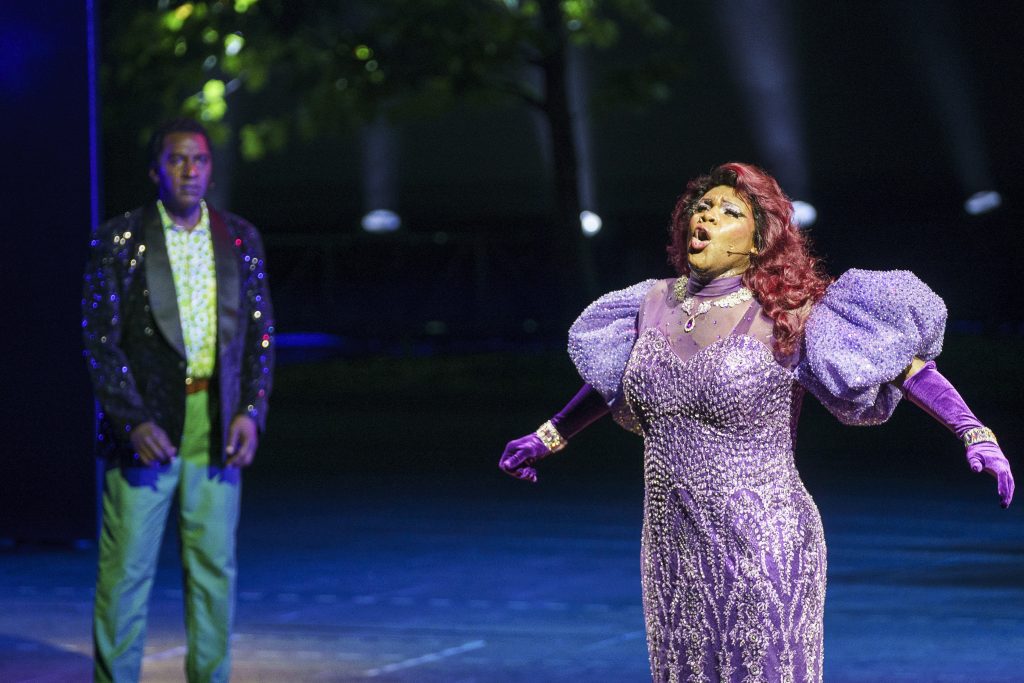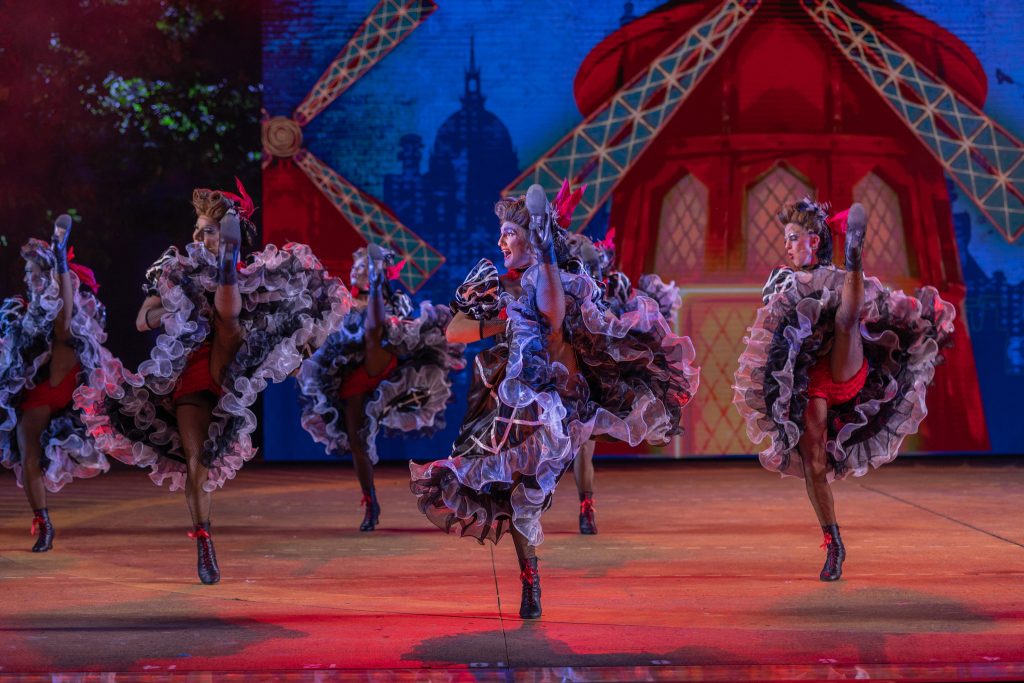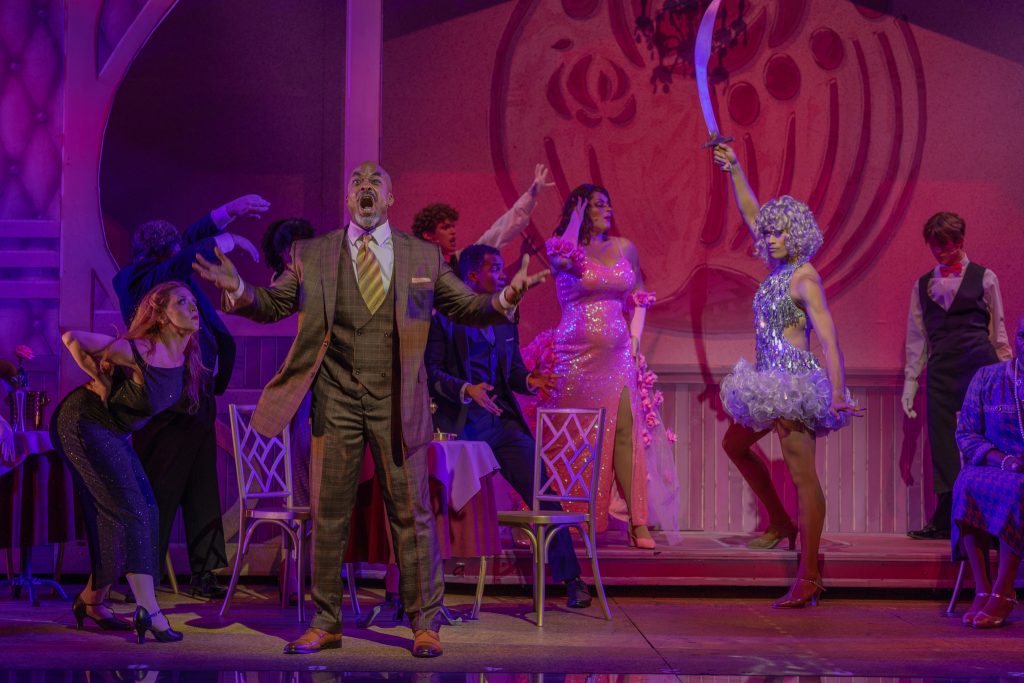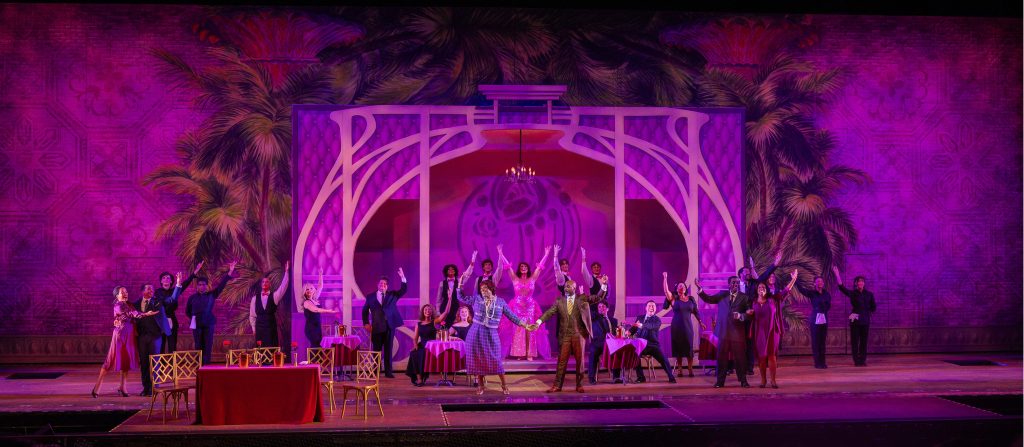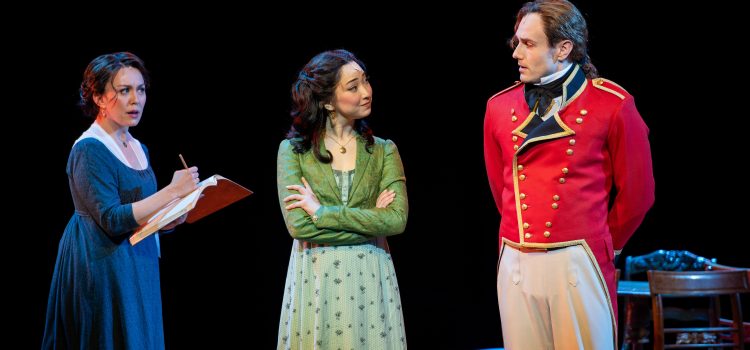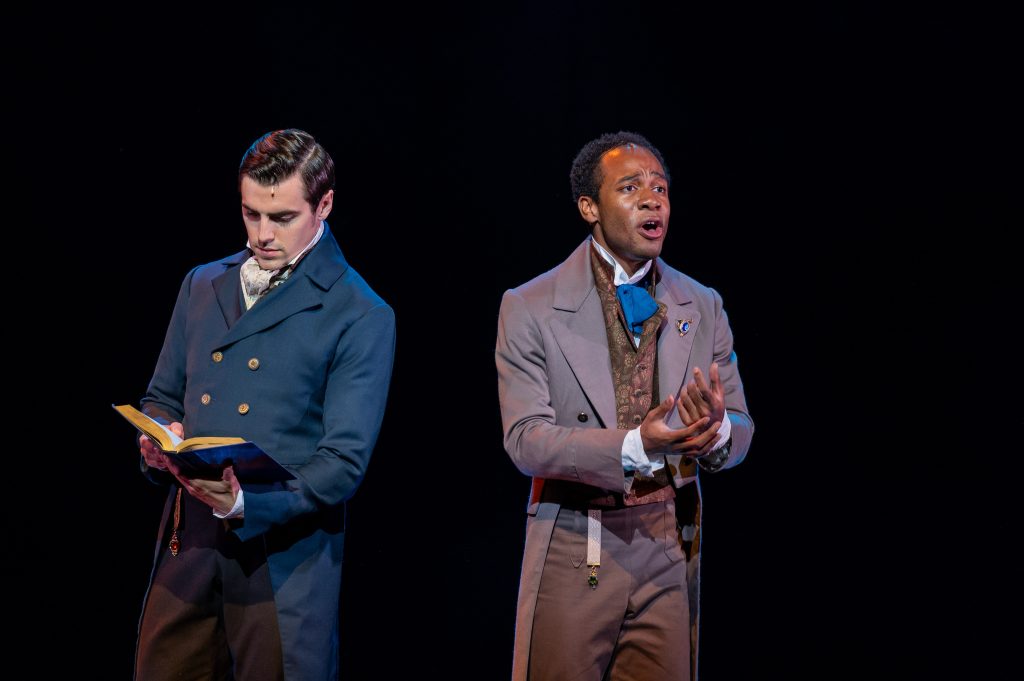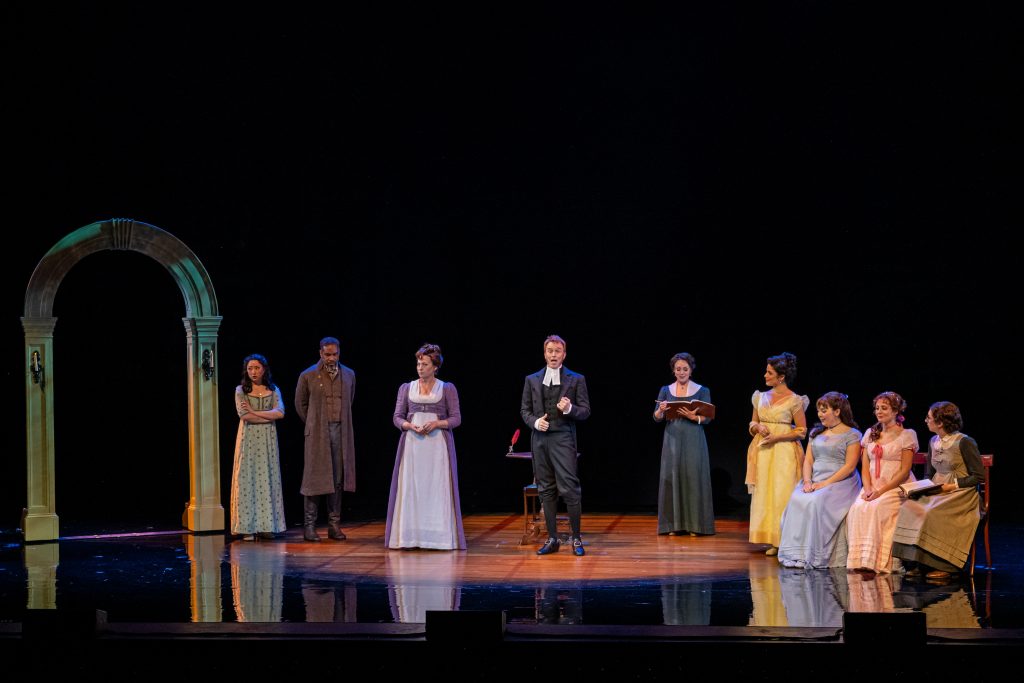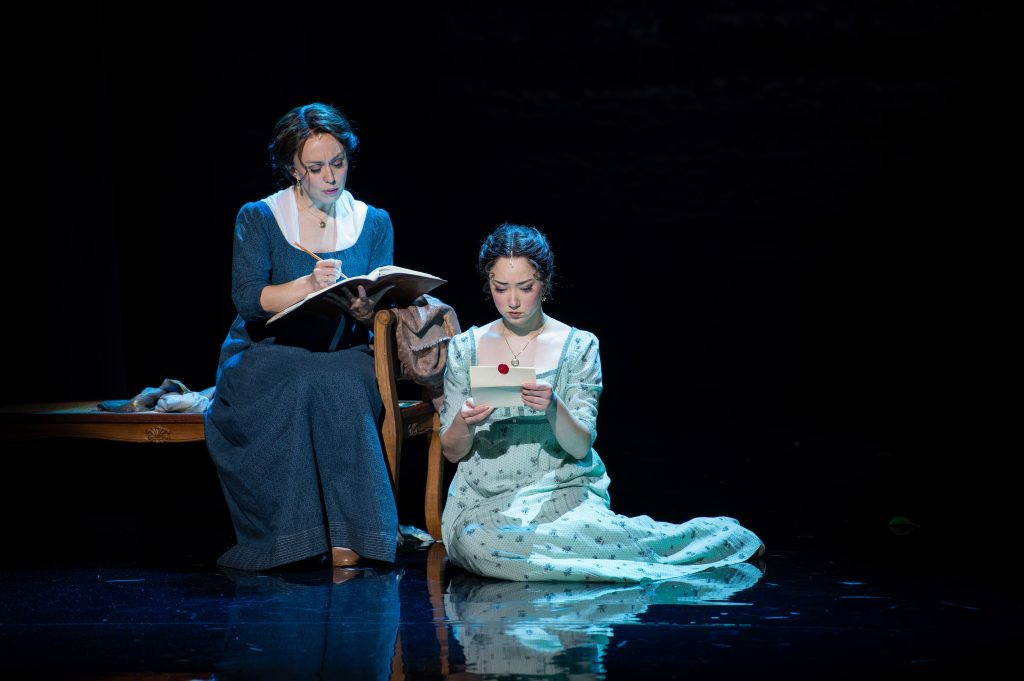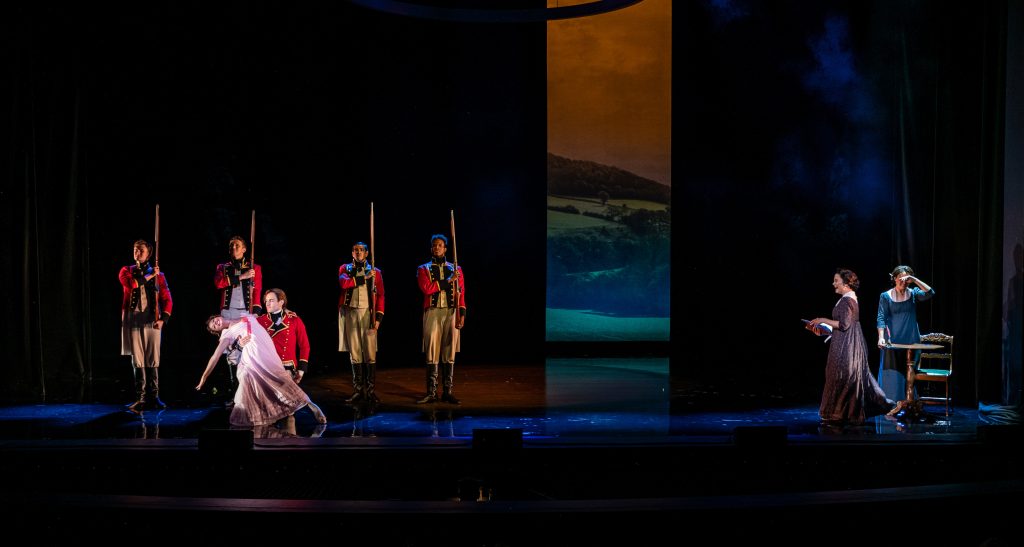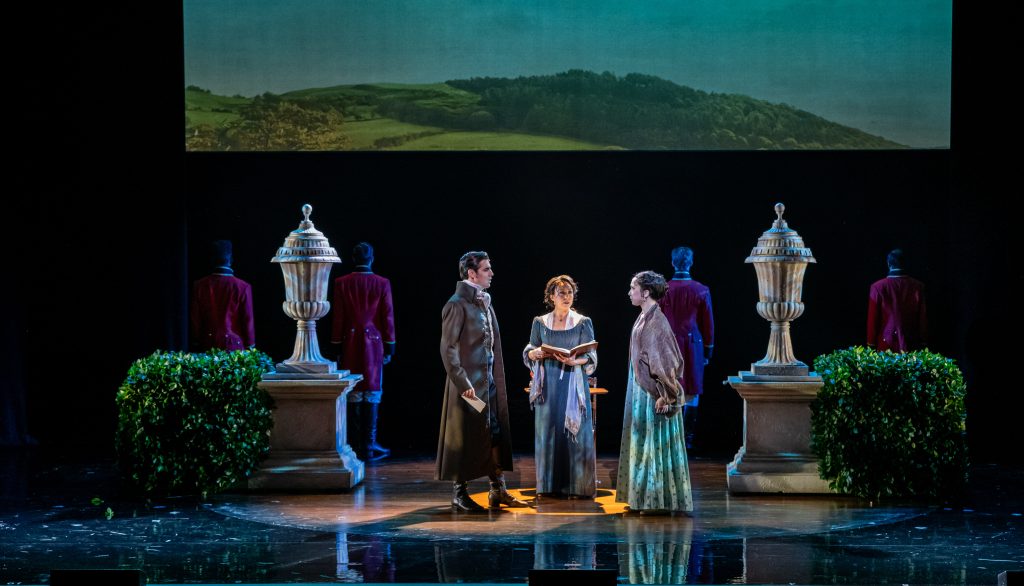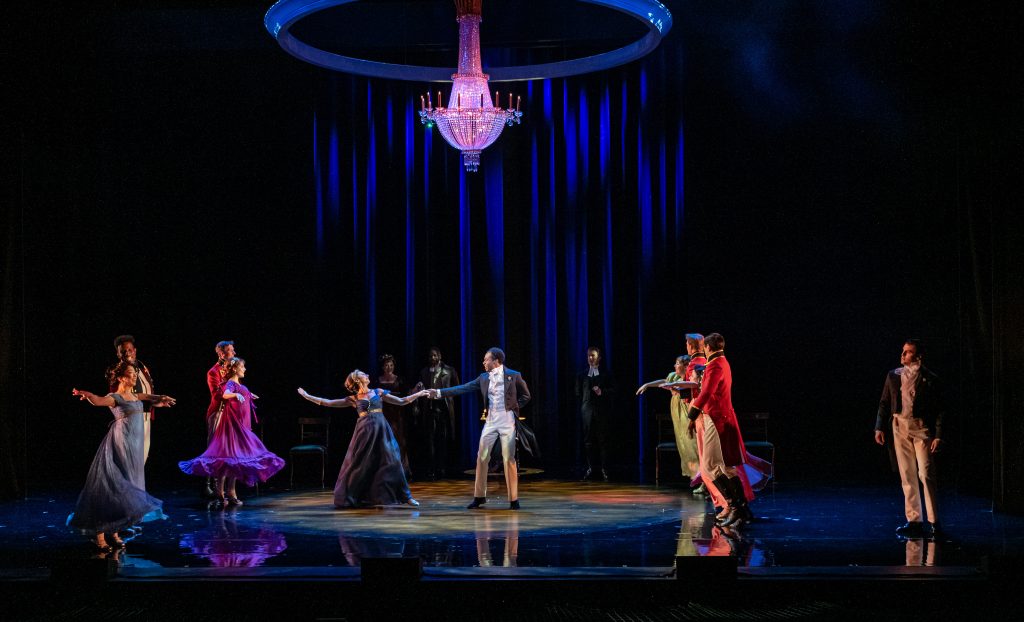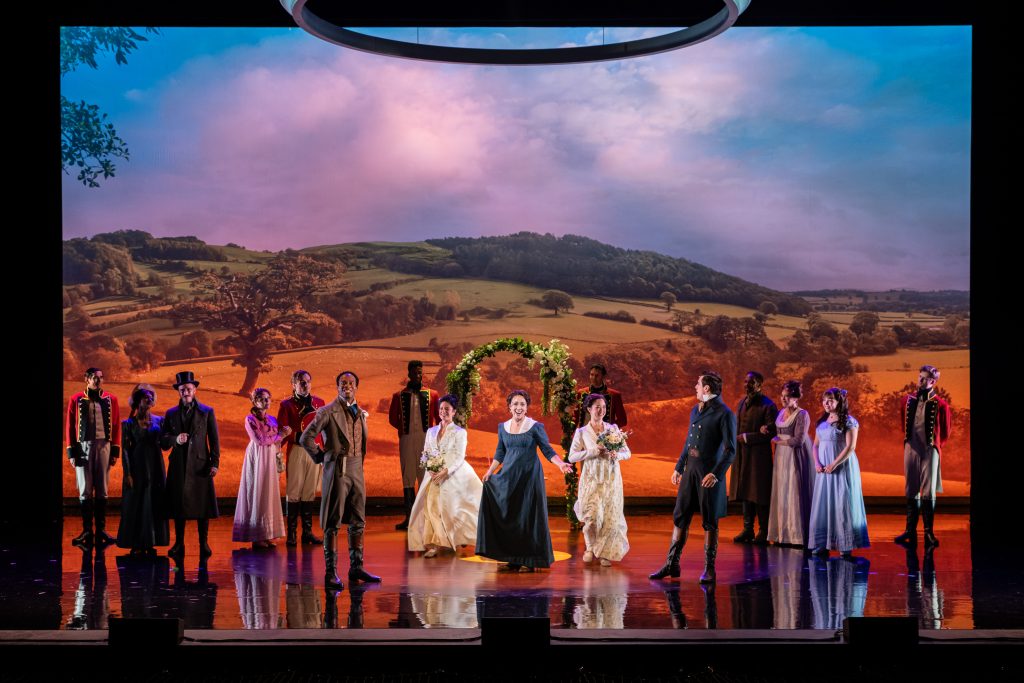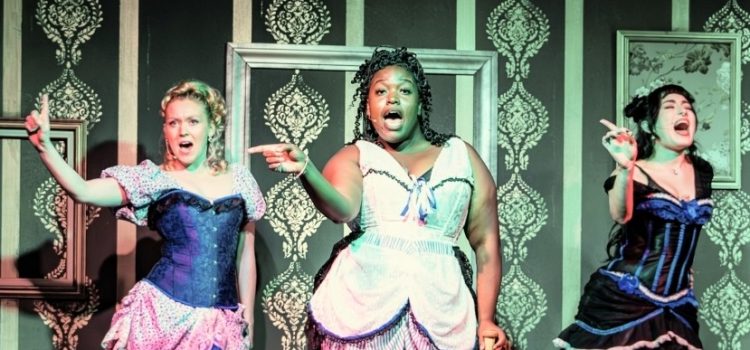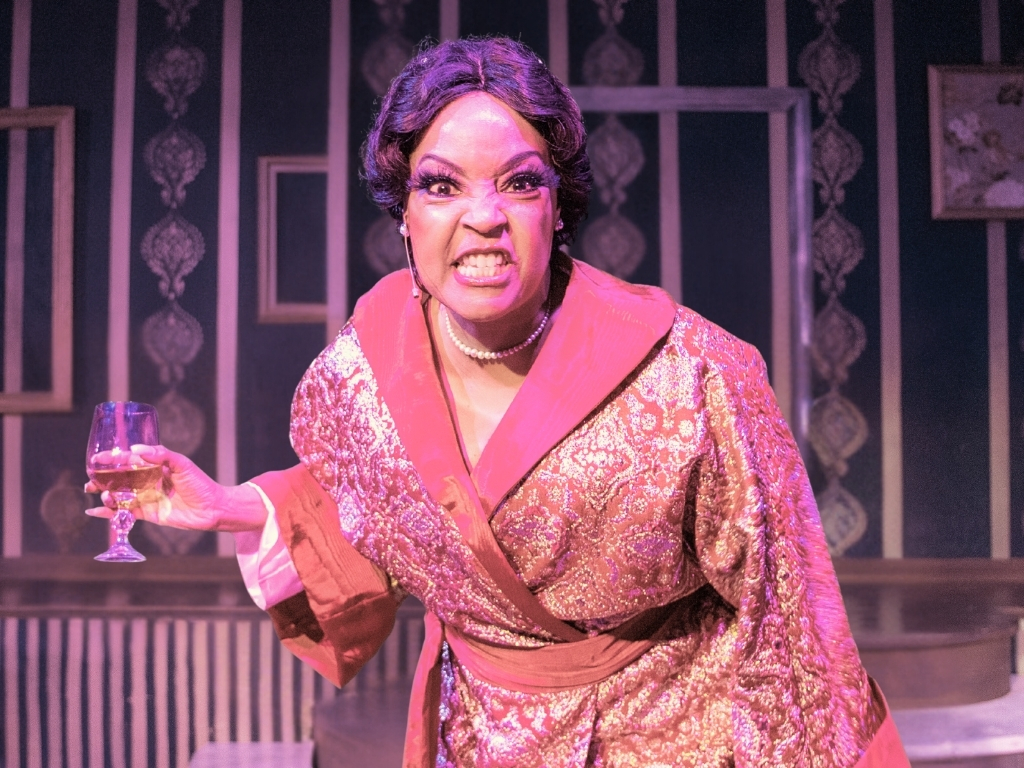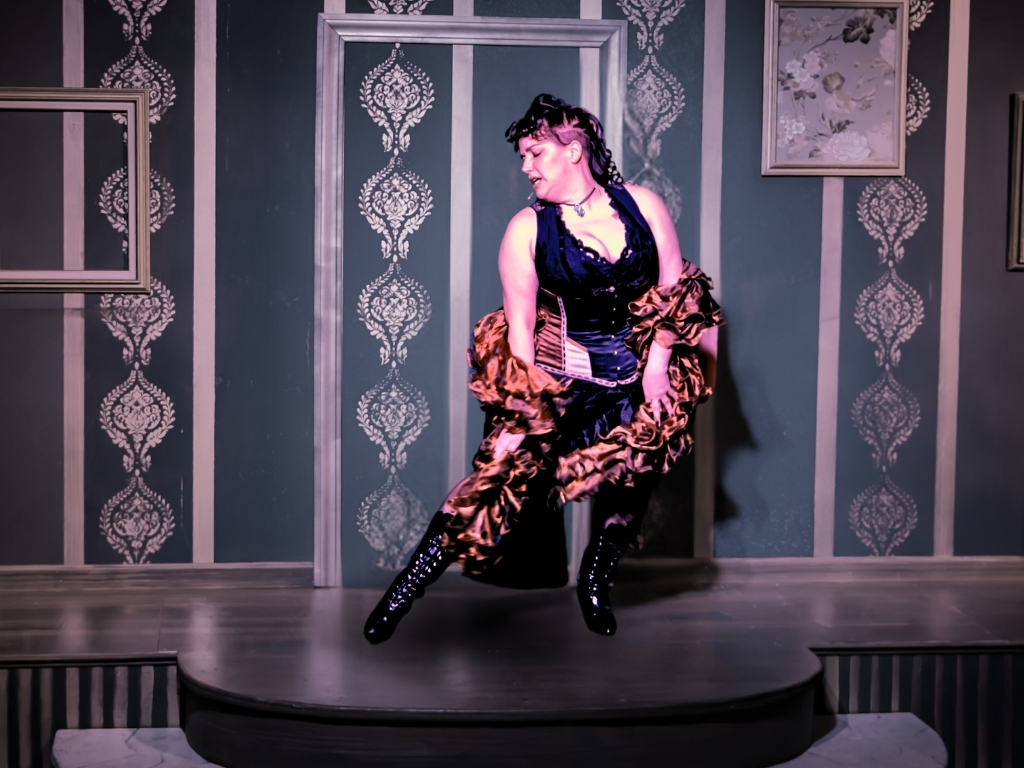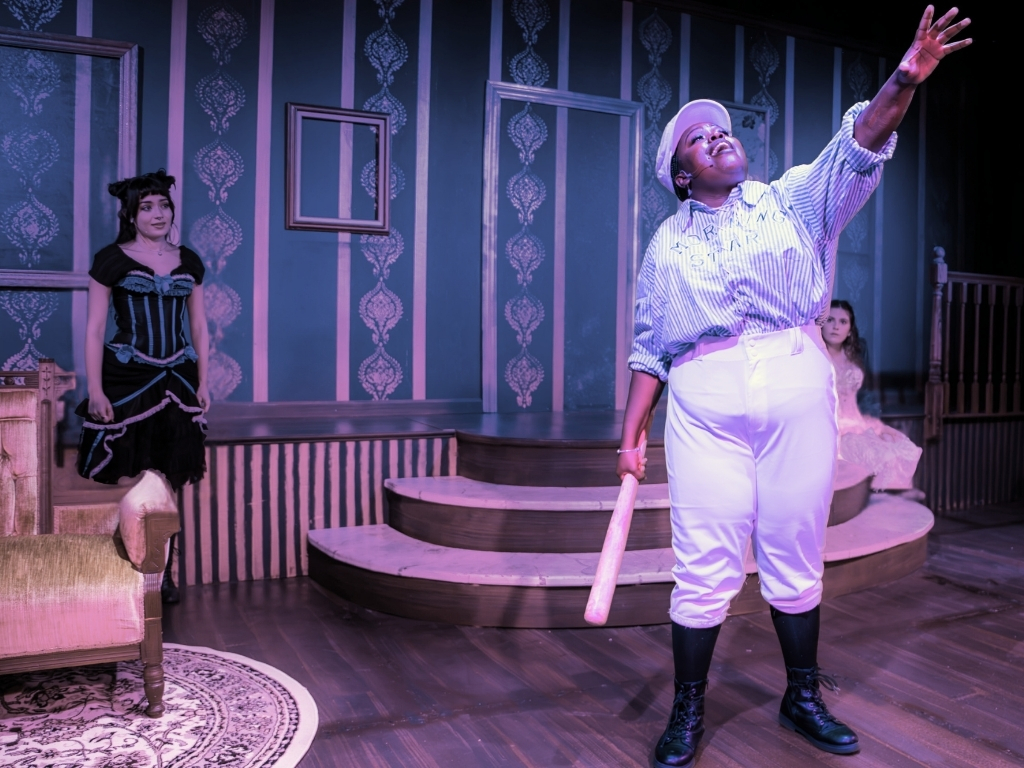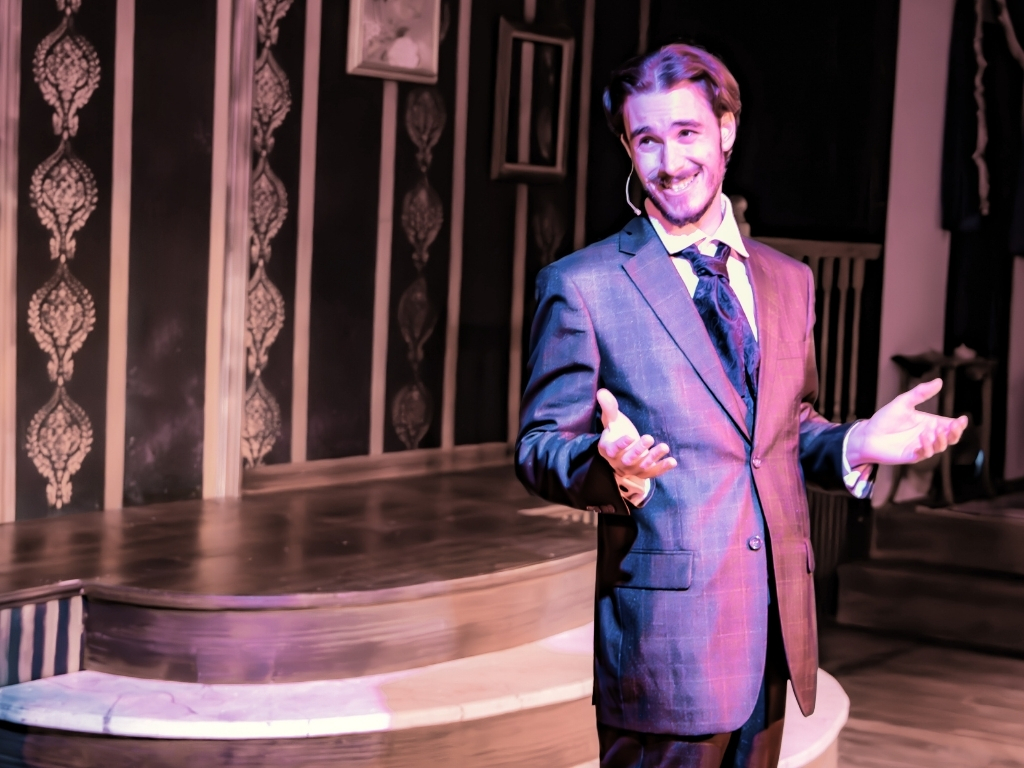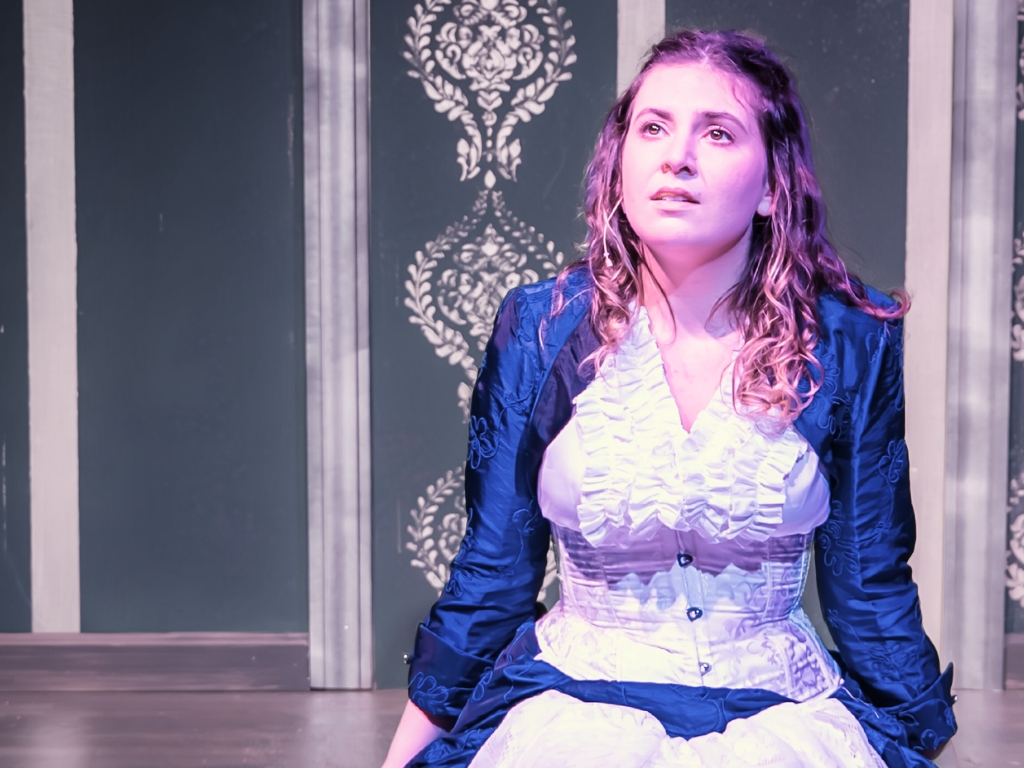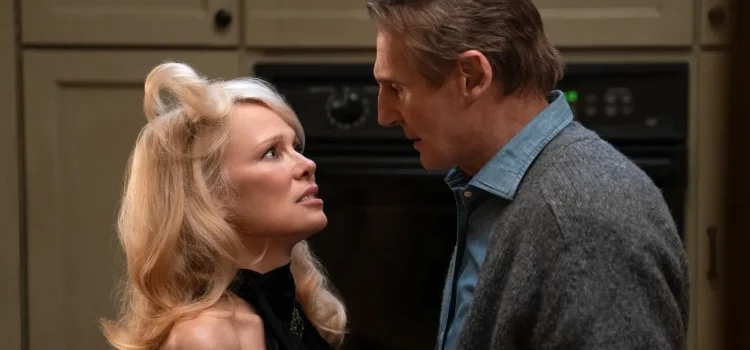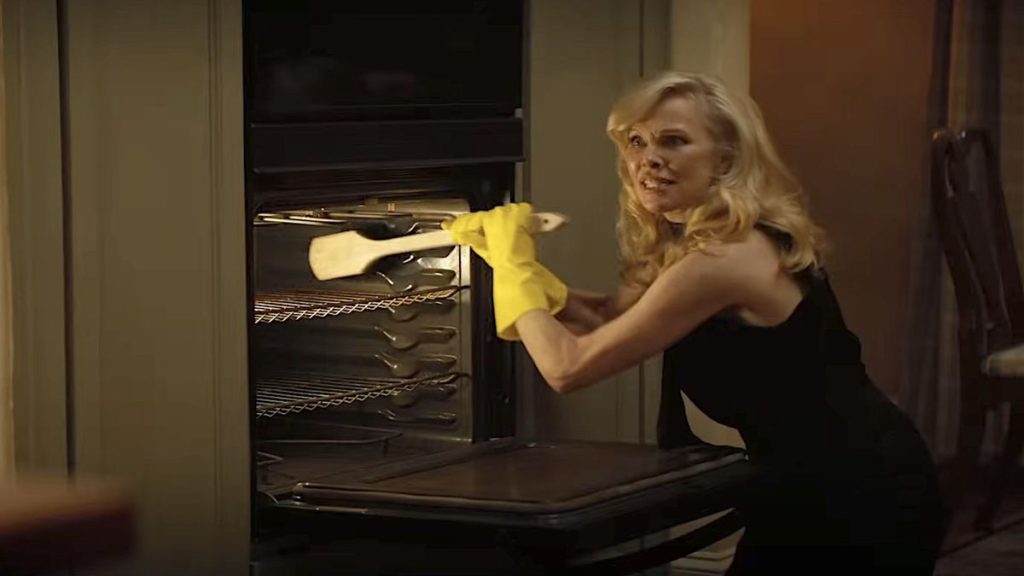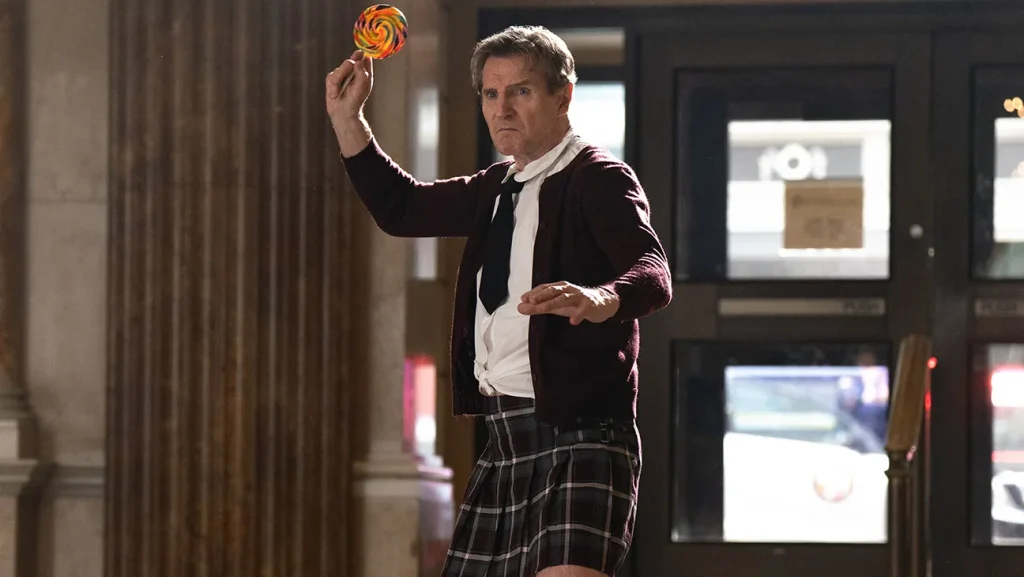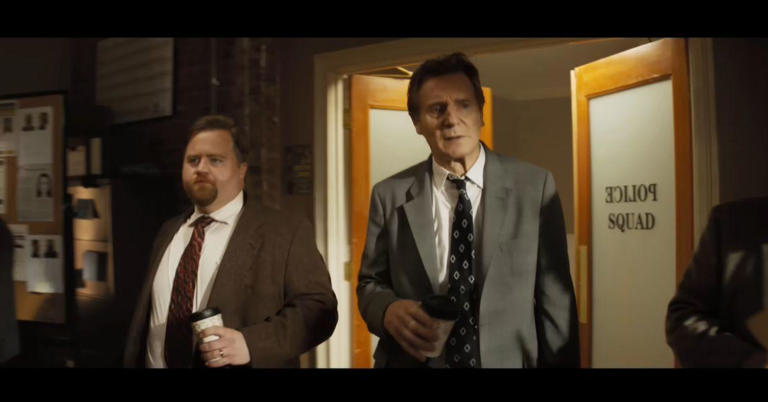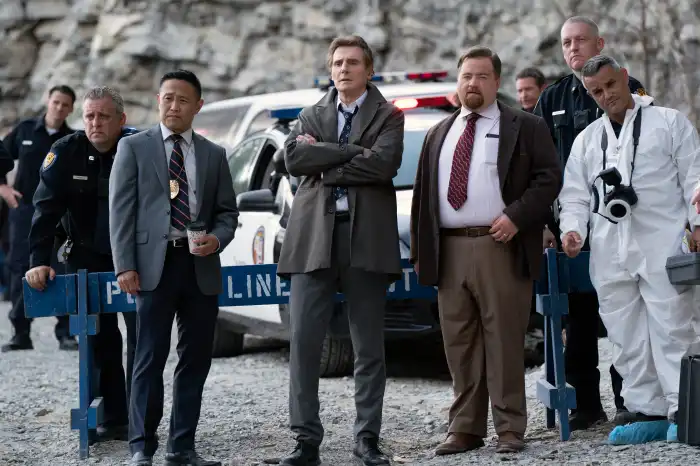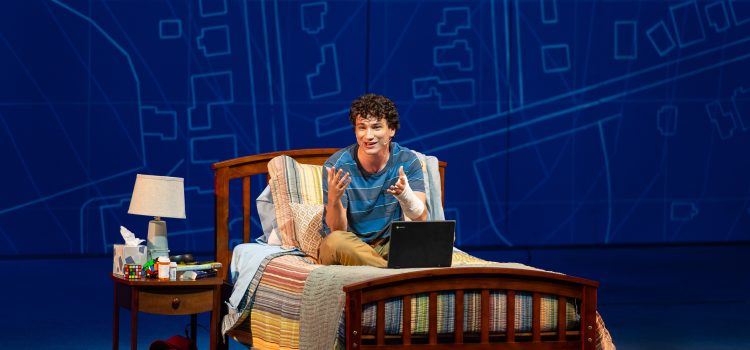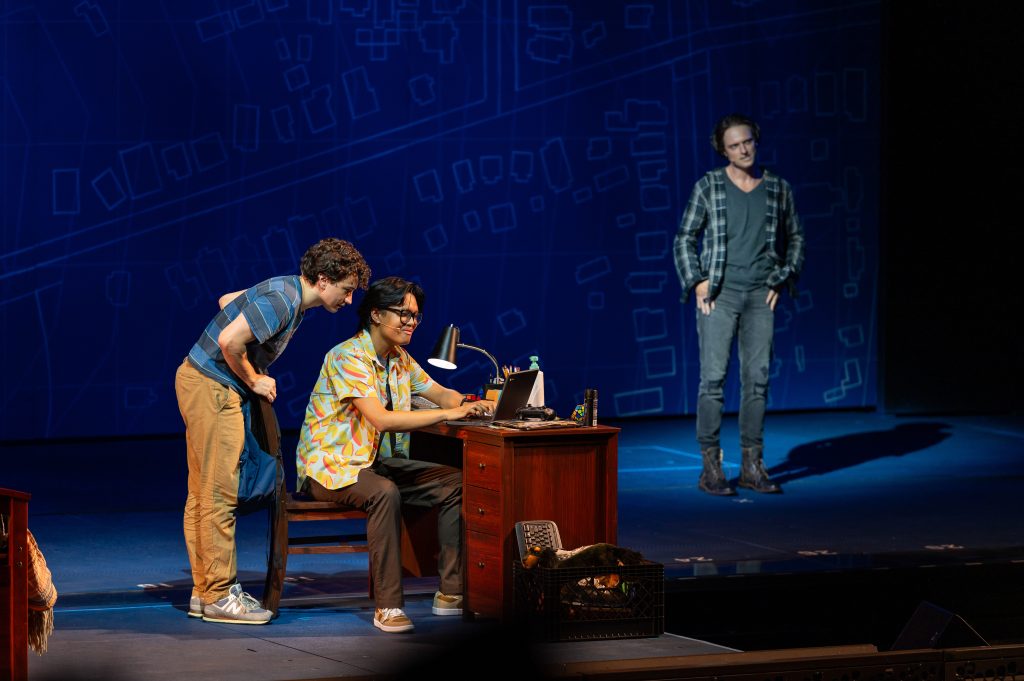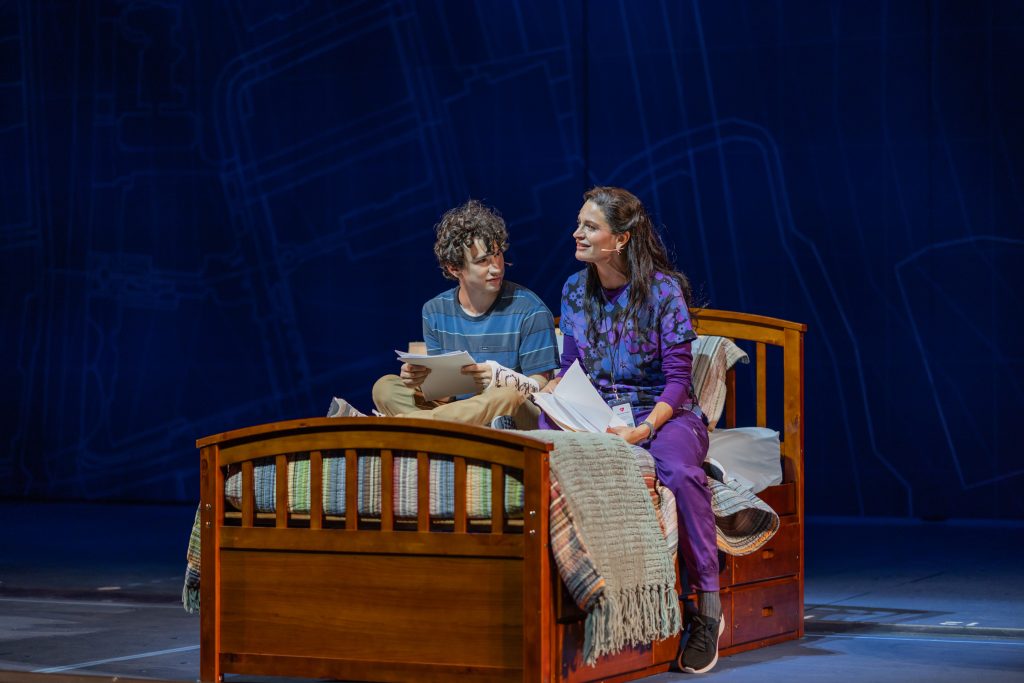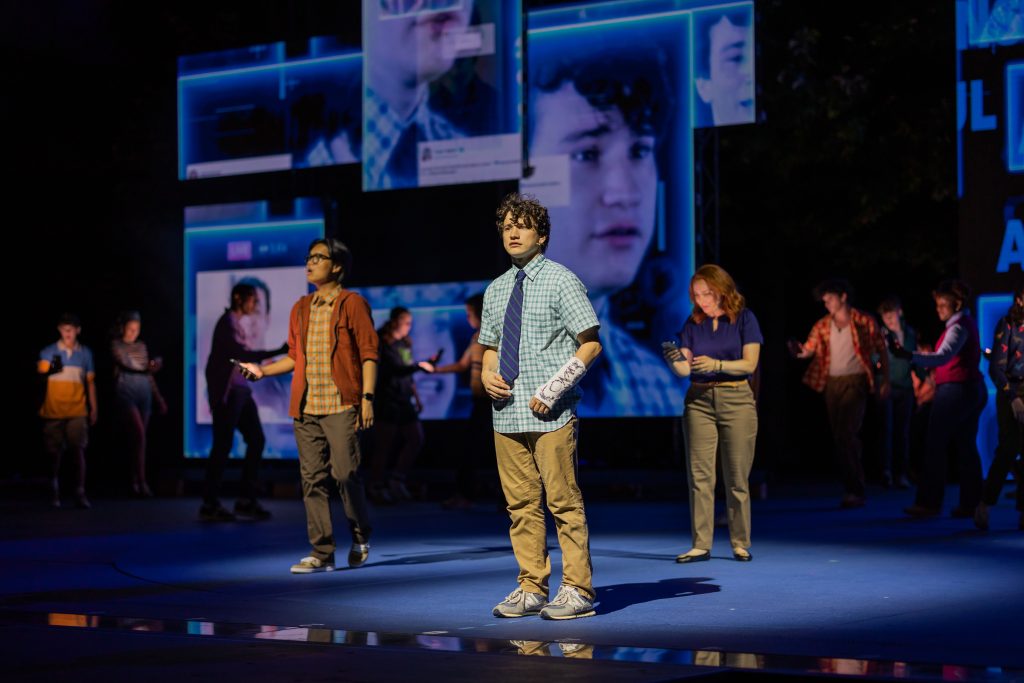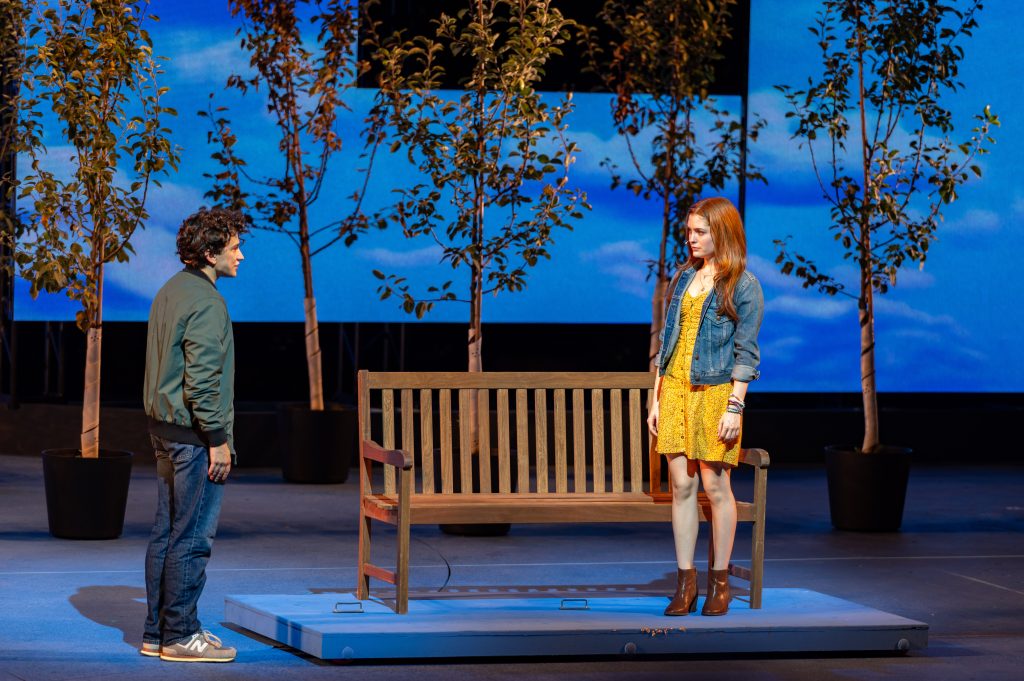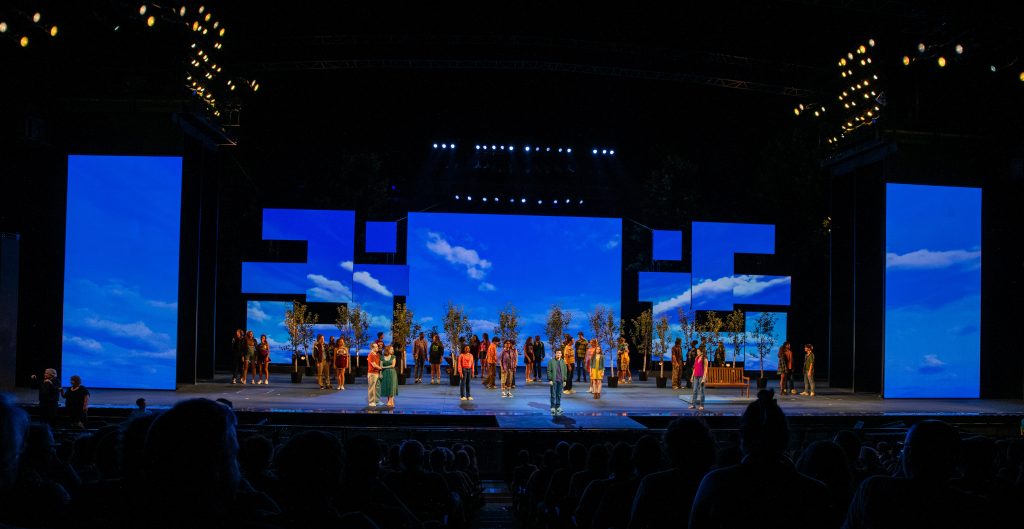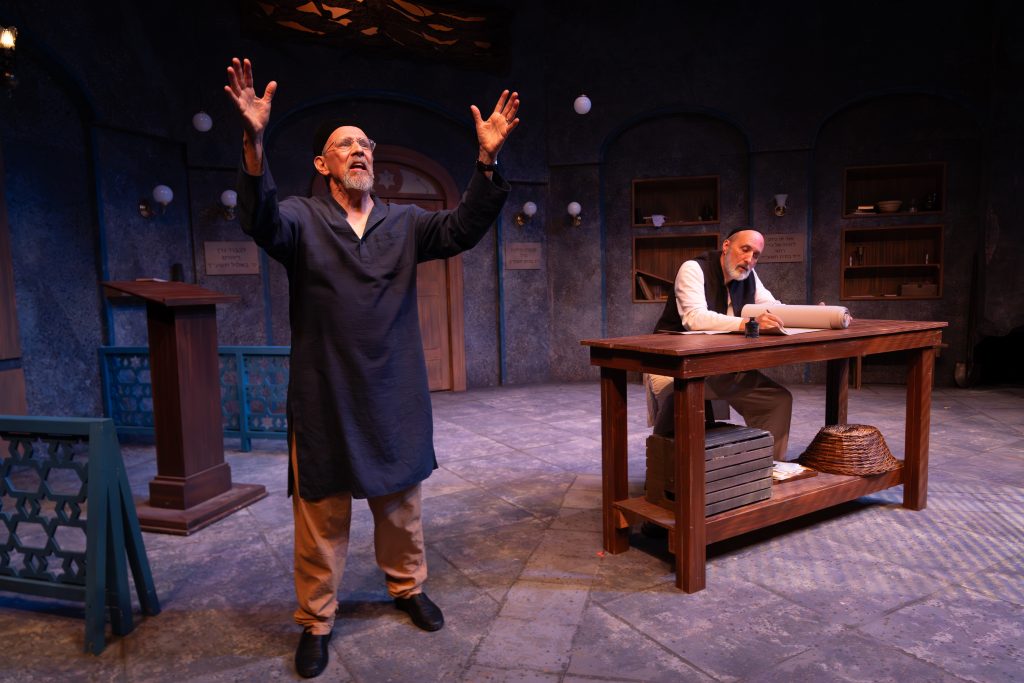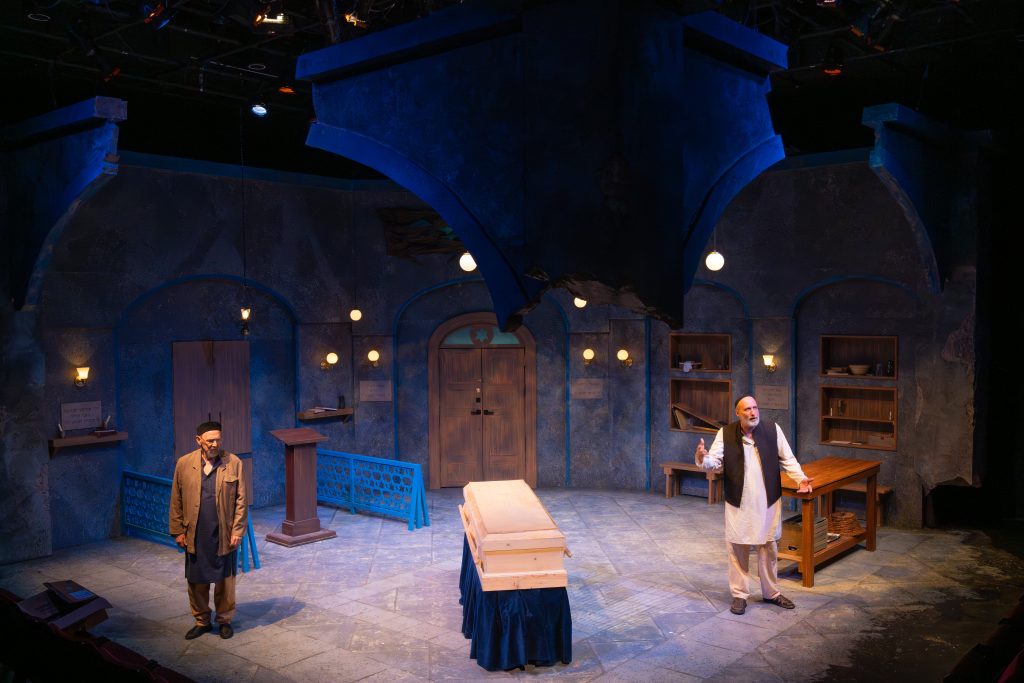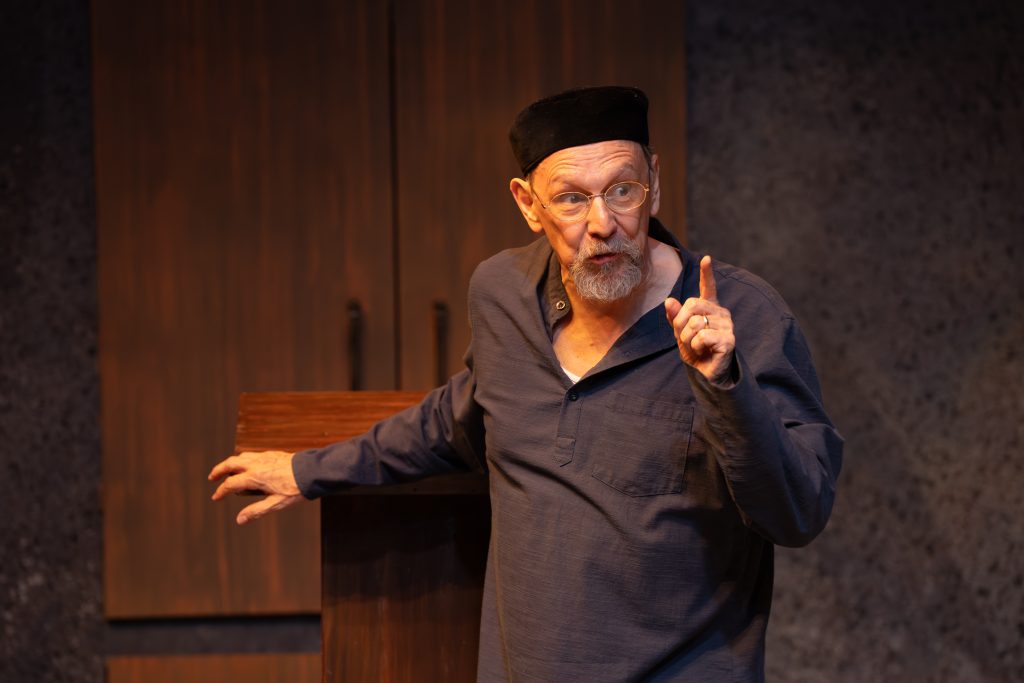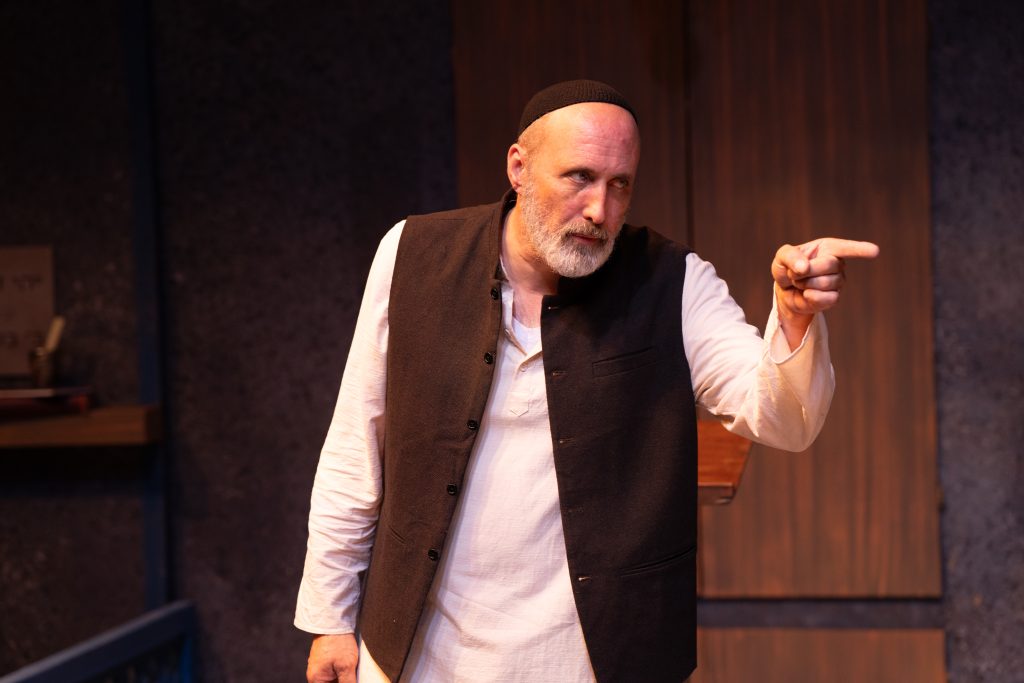By Lynn Venhaus
“But the first time the four of us made that sound, our sound, when everything dropped away and all there was, was the music…that was the best,” – Frankie Valli
With its focus on the driven, determined and dynamic brotherhood who became the enduring superstar quartet The Four Seasons, their lively legacy lives on in the Muny’s crowd-pleasing rolling ball of thunder “Jersey Boys.”
A celebrated smash hit around the world, the smartly constructed Tony winner is a can’t-miss bio-jukebox musical because of its vibrant staging, captivating storytelling and unforgettable sound.
Not only featuring a substantial collection of hits, the charming combination of showbiz spectacle and personal struggles connect with generations authentically, garnering empathy, and the group’s hard-won success resonates.
The rags-to-riches true stories of Frankie Valli (Pablo David Laucerica), Bob Gaudio (Andrew Poston), Tommy DeVito (Ryan Vasquez) and Nick Massi (Cory Jeacoma), blue-color kids from a tough Italian neighborhood in Belleville, New Jersey, are detailed in Marshall Brickman and Rick Elice’s straight-shooting documentary-style book.
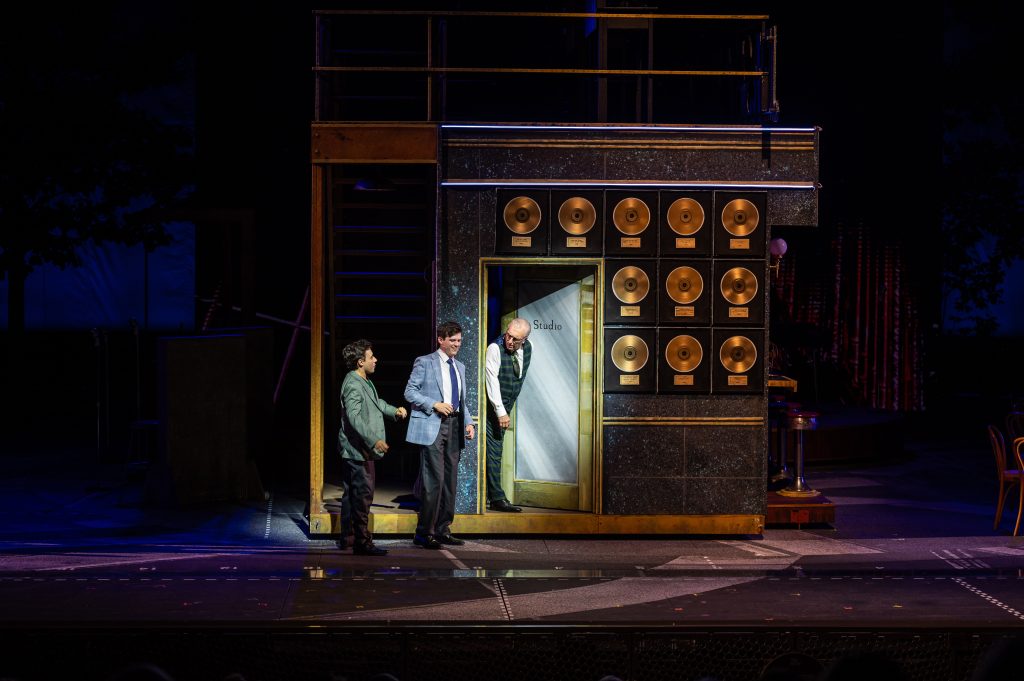
By presenting four different points of view, they also broke the Fourth Wall, where characters talk directly to the audience, and each one narrates their version. Being wise street guys, their salty dialogue is peppered throughout the two acts. They sure were entertaining, on stage and off.
The writing pair deftly integrated the group’s tough times and glorious moments in between 34 songs, their placement depending on recordings timeline or a means to emphasize real events.
With lead singer Valli’s unmistakable falsetto, songwriter/keyboard player Gaudio’s catchy melodies, De Vito’s guitar, and Massi’s bass, their signature sound sold 175 million records and was an essential cultural touchstone of the 1960s-1970s.
The quartet features three strong actors making their Muny debut. Indefatigable Pablo David Laucerica is a dynamo as legendary Valli, acting “Like that bunny on TV, I just keep going and going and going. Chasing the music. Trying to find our way home.”
Flashing a radiant smile often, Laucerica pours his heart and soul into the songs, and while he superbly delivers upbeat pop and moving ballads equally, one of his best numbers is the heartbreaking “Fallen Angel” about the tragic death of his daughter at 22. Frankie convincingly wrestles with his desire to perform and the need to spend more time with his family.
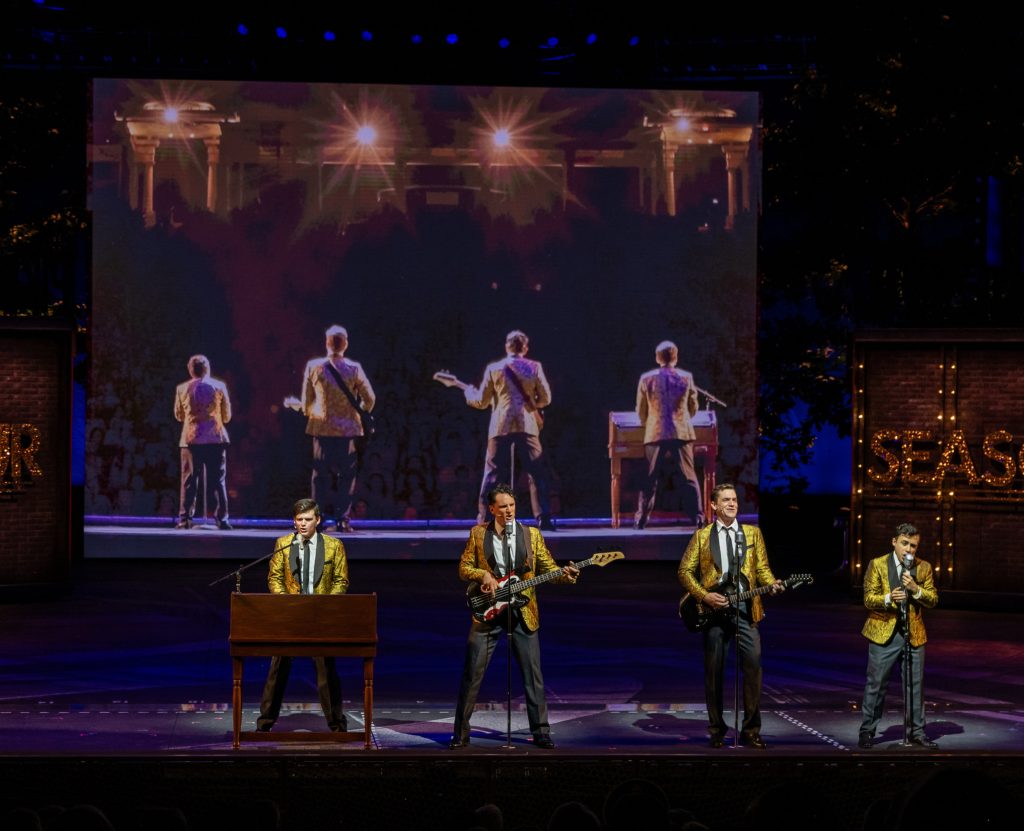
Poston is appealing as boyish Gaudio, the self-assured songwriting wizard, while Jeacoma adds some fine-drawn heft to his Massi characterization, more than just a quirky figure eliciting laughs as the self-proclaimed “Ringo.” He’s an accomplished ‘Jersey Boys’ veteran (as is Laucerica).
In his second Muny appearance after his scene-stealing turn as the sadistic dentist in “Little Shop of Horrors” in 2023, Vasquez provides the braggadocio and is an imposing figure in his intense portrayal of slick sharp-tongued troublemaker DeVito. It’s a noteworthy muscular performance.
While they took a while to find their rhythm in the musical numbers, the four eventually clicked, their silky-smooth 4-part harmonies gelling along with their snappy movements. In their passionate portrayals, though, they established a fine rapport with each other for an immediate close-knit feeling.
First-time music director Paul Byssainthe Jr. cohesively conducted the 25-piece orchestra, emphasizing a sensational horn section that shines in the upbeat numbers.. The actors playing musicians exhibit some stylish moves.
Choreographer William Carlos Angulo’s larger dance numbers are appropriately peppy, but there is one puzzling dance interlude during a Valli solo, after his daughter’s passing. Nevada Riley, a young female dancer, enters alone, and dances in the dark, no illumination whatsoever – so how many people saw it? Could shadows have been more effective?
Wouldn’t lighting designer Rob Denton have enhanced that? Denton, one of the best in the business, has dramatically illuminated music scenes and intimate interactions effectively here. truly stunning work establishing the scenes..
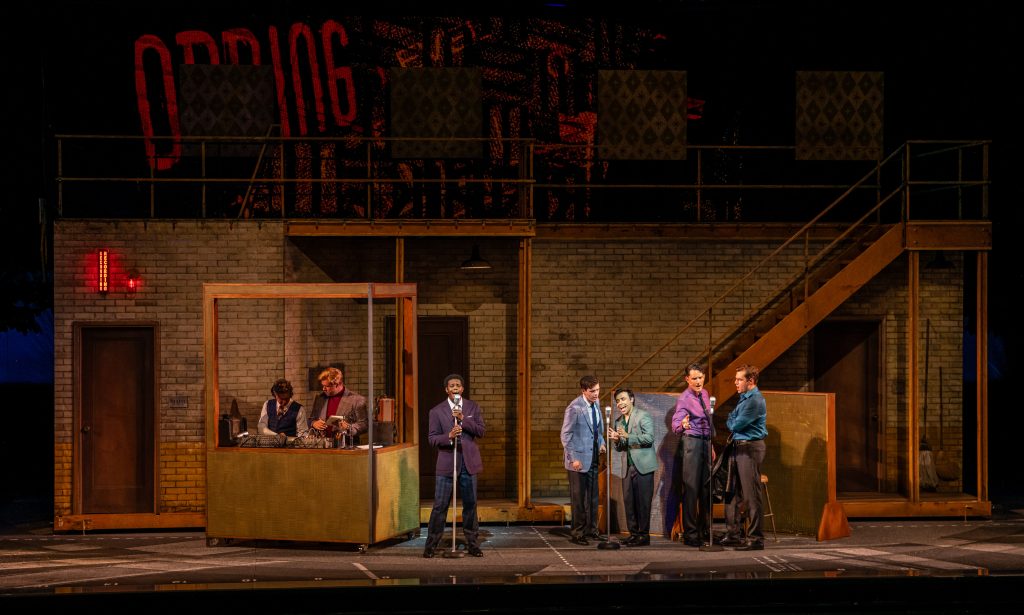
The Muny’s creative team transports us to the 1960s, from the smoky clubs to humble digs, to a fabled Brill Building recording studio, taping of “American Bandstand,” “The Ed Sullivan Show,” and other milestones in the 1970s and 1990. Set designer Krit Robinson has crafted a simple grid for all the moving pieces, some gritty, some finer quarters.
Costume designer Leon Dobkowski conjures up attractive vintage period pieces and status outfits, with glitzy dance and singing attire getting fancier as the gigs get bigger.
The creative eye-popping video designs by Kylee Loera and Greg Emetaz immerse us in the music business and frame the times. They incorporated hand-held cinema verité footage of interviews with the older Four Seasons, played by Drew Battles, Michael James Reed, and Jerry Vogel. The smooth, seamless integration is some of their best work.
For the Rock Hall induction scene, some members of the audience appeared confused, thinking that the older actors were the real Four Seasons when they came on stage in tuxedos. They stood up cheering, snapping photos. Unfortunately, only two of the actual members are living – Gaudio and Valli, and they were not present. (However, Gaudio did make an appearance in 2018, being introduced one night to the Muny crowd.)

For anyone that considers these timeless songs part of the soundtrack of their lives, this is a nostalgic boogaloo down memory lane. It’s not only Boomer bliss, or for fans only, but other generations can appreciate the universal themes of ambition, friendship, love, disappointment, heartbreak and making your dreams come true.
Director Maggie Burrows presented the major music numbers with panache, especially the back-to-back hits “Sherry” (their first hit in 1962), “Big Girls Don’t Cry,” “Walk Like a Man,” and “Ragdoll.” The ‘earworm’ tunes keep coming in robust fashion — “Let’s Hang On,” “Working My Way Back to You,” “C’mon, Marianne” and “Stay” among them.
Standing out are thrilling interpretations of “December 1963 (Oh, what a Night)” – their last no. 1 hit in 1976, “Can’t Take My Eyes Off of You,” and “Who Loves You,” a rousing finale that had the crowd on its feet – and singing and clapping along to the forever hummable “December 1963” encore/curtain call.
The iconic “Can’t Take My Eyes Off of You,” released in April 1976, has a fascinating backstory that gets its deserving Muny moment. After being turned down, the embattled song was among his biggest hits, earning a gold record and reaching No. 2 on the Billboard Hot 100 for a week, making it Valli’s biggest solo hit until he hit No. 1 in 1975 with “My Eyes Adored You.” Solid gold first time out of the gate as a solo artist.
With an extended ovation and loud cheers for Laucerica’s virtuoso rendition, that reaction indicated it was an audience favorite. And the staging, with its silhouetted horn section, was a nifty touch.

In fine support are Shea Coffman as record producer and lyricist Bob Crewe (but saddled with an ill-fitting wig), John Leone – who was in the original Broadway cast — as business leader, family man and fixer Gyp de Carlo, Mike Cefalo as Joe Pesci (yes, that Joe Pesci), and Tristen Buettel as Frankie’s first wife, Mary Delgado.
Of course, the ensemble seamlessly plays multiple roles. D’Marreon Alexander, Matt Faucher, Stephanie Gomerez, Reina Guerra, Jimin Moon, Ben Nordstrom, Matt Rivera, and Fernando Trinidad III complete the ensemble, with Kaley Bender and Noah Van Ess as swings.
Currently, the 13th longest-running show on Broadway with 4,642 performances, “Jersey Boys” ran for 11 years from Nov. 6, 2005, to Jan. 15, 2017. In 2006, it won four Tony Awards, including Best Musical, Actor, Featured Actor and Lighting Design.
As the first theater to present it after the Broadway run, residence companies and national tours, The Muny featured it as a world regional premiere during the 100th year centennial season in 2018, and the joint was jumping.
While this production could have been tighter and crisper (under-rehearsed, affected by oppressive heat, perhaps?), overall, it is a rollicking, entertaining evening.

This quintessential American Dream tale hasn’t lost its luster. Come for the classic hits, enjoy the laughter, delivered vigorously. Humor abounds, so do emotional tugs through their relatable journey navigating the pitfalls of fame and money.
Leaving with enough good vibes to remain uplifted, I haven’t been able to get the songs out of my head since I exited the outdoor Muny stage Tuesday for the final show of the redefining and memorable 107th season.
How lucky we are to be alive right now, connecting with each other through the time-honored tradition of sitting under the stars and seeing Broadway-quality shows Muny-style. Onward and upward for next summer!
The Muny presents “Jersey Boys” from Aug. 18 through 24 at the outdoor stage in Forest Park. It is 2 hours, 20 minutes and has an intermission. This has adult content. For tickets, go to: www.Muny.org or call the box office at 314-361-1900, located at 1 Theatre Drive in Forest Park, or MetroTix at 314-534-8111.
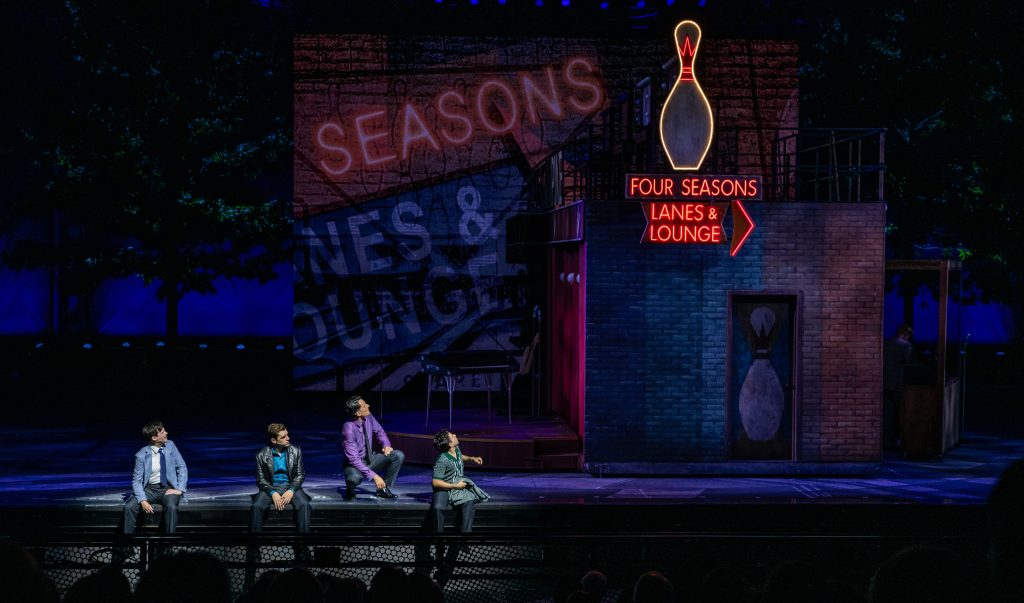
The 108th Season
The Muny will announce the seven shows in its 2026 season on Dec. 1, which happens to be Cyber Monday. The invitation-only live event will be livestreamed for virtual participation. Time will be announced later.
For the first time, subscribers can renew current tickets or secure new season tickets when they unveil the season 108 lineup.
.
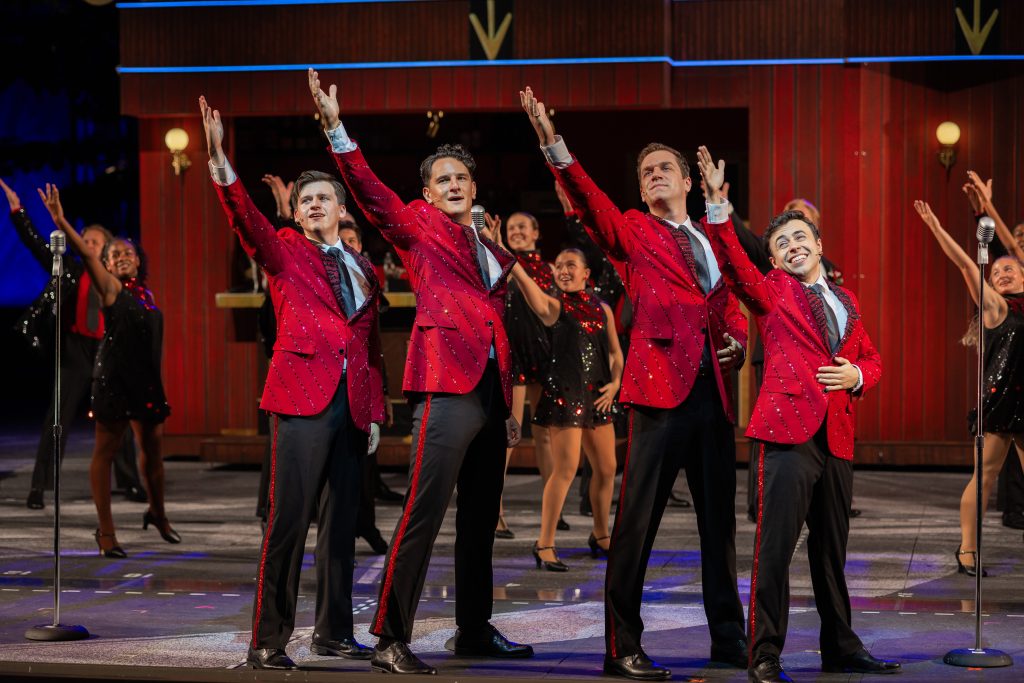
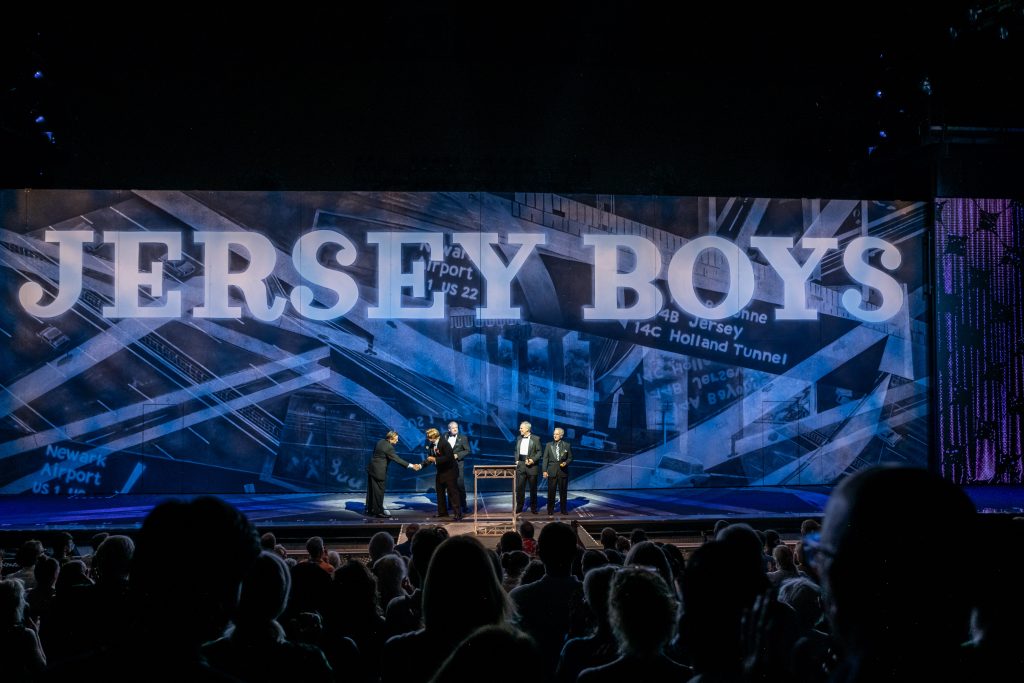

Lynn (Zipfel) Venhaus has had a continuous byline in St. Louis metro region publications since 1978. She writes features and news for Belleville News-Democrat and contributes to St. Louis magazine and other publications.
She is a Rotten Tomatoes-approved film critic, currently reviews films for Webster-Kirkwood Times and KTRS Radio, covers entertainment for PopLifeSTL.com and co-hosts podcast PopLifeSTL.com…Presents.
She is a member of Critics Choice Association, where she serves on the women’s and marketing committees; Alliance of Women Film Journalists; and on the board of the St. Louis Film Critics Association. She is a founding and board member of the St. Louis Theater Circle.
She is retired from teaching journalism/media as an adjunct college instructor.

